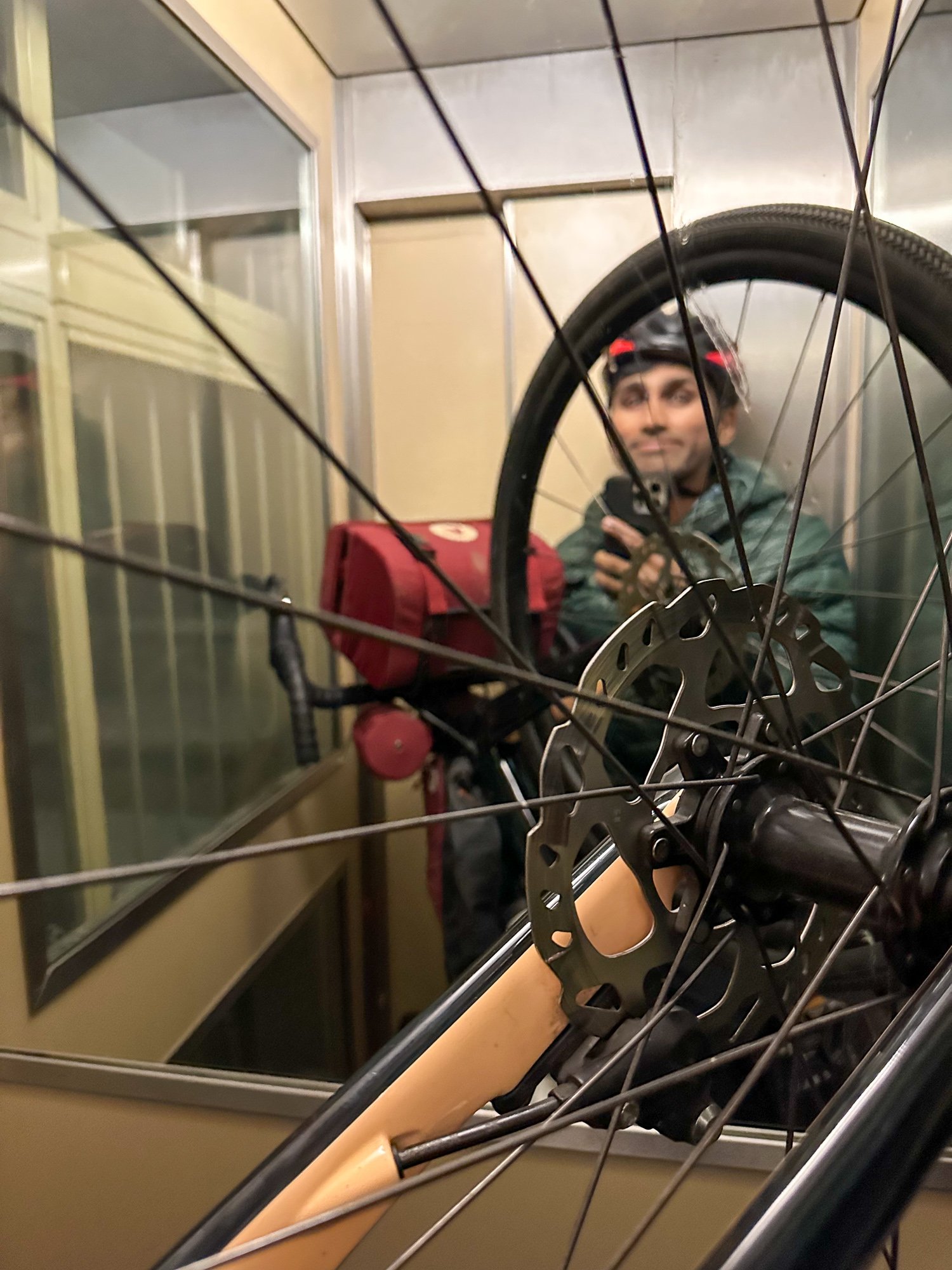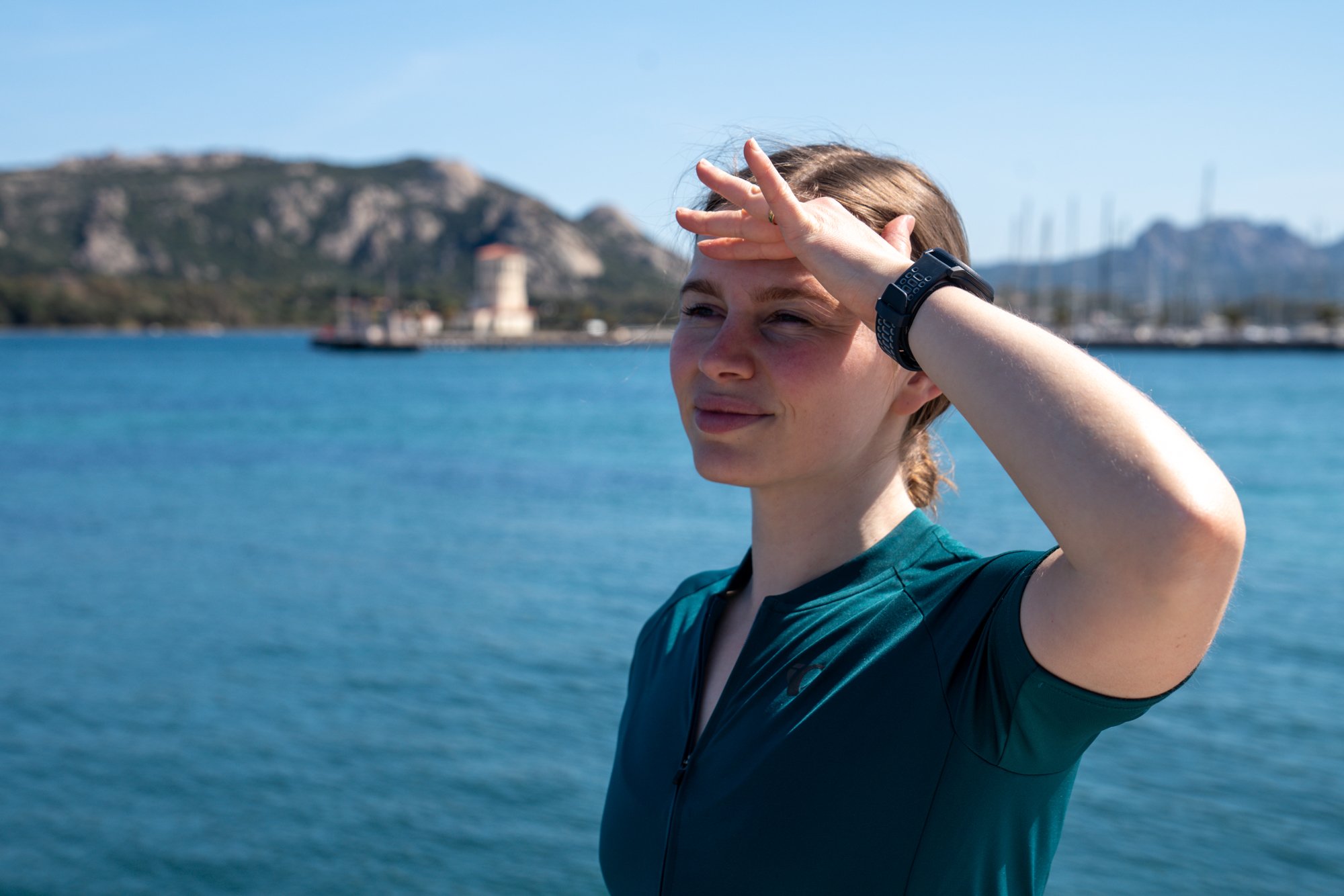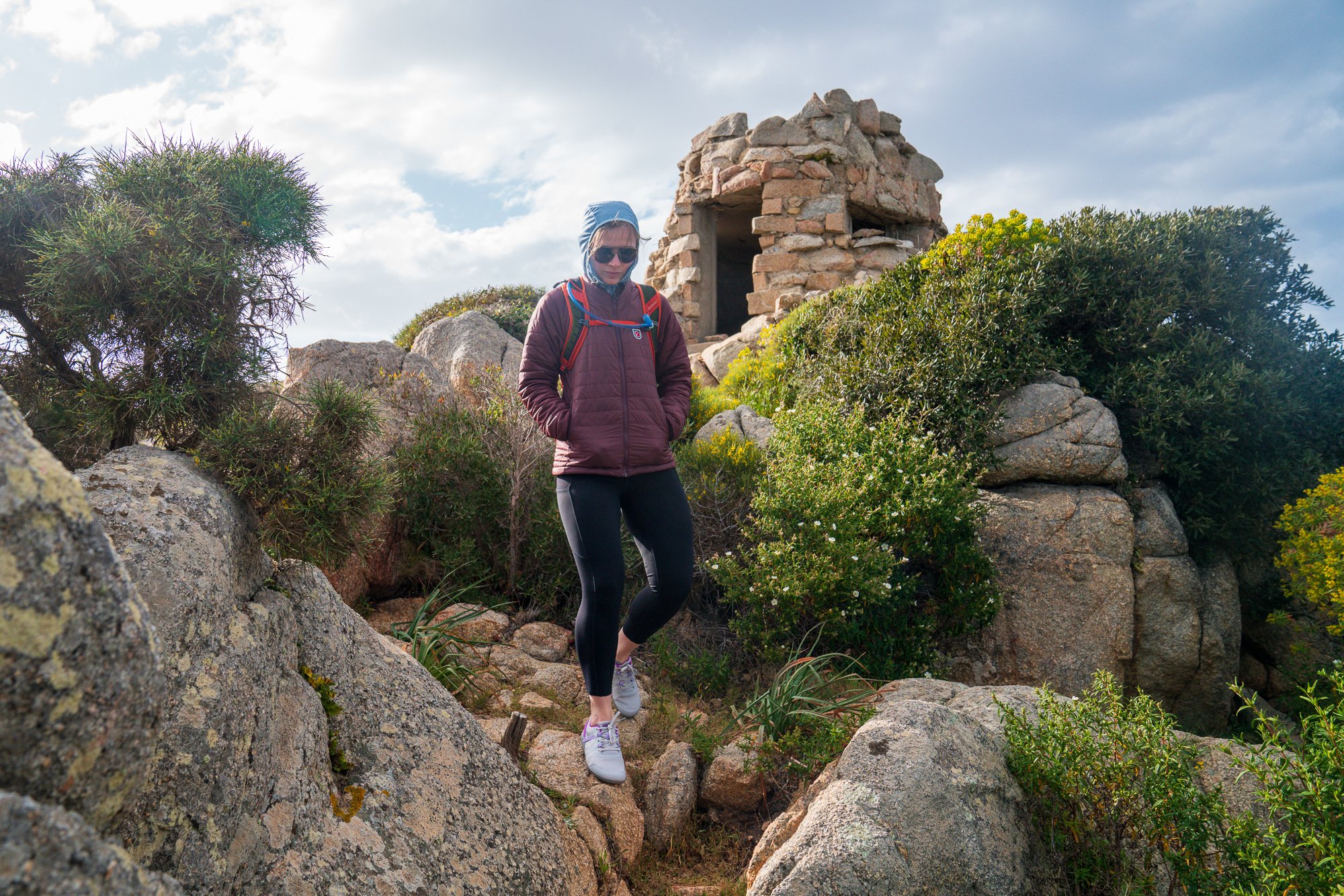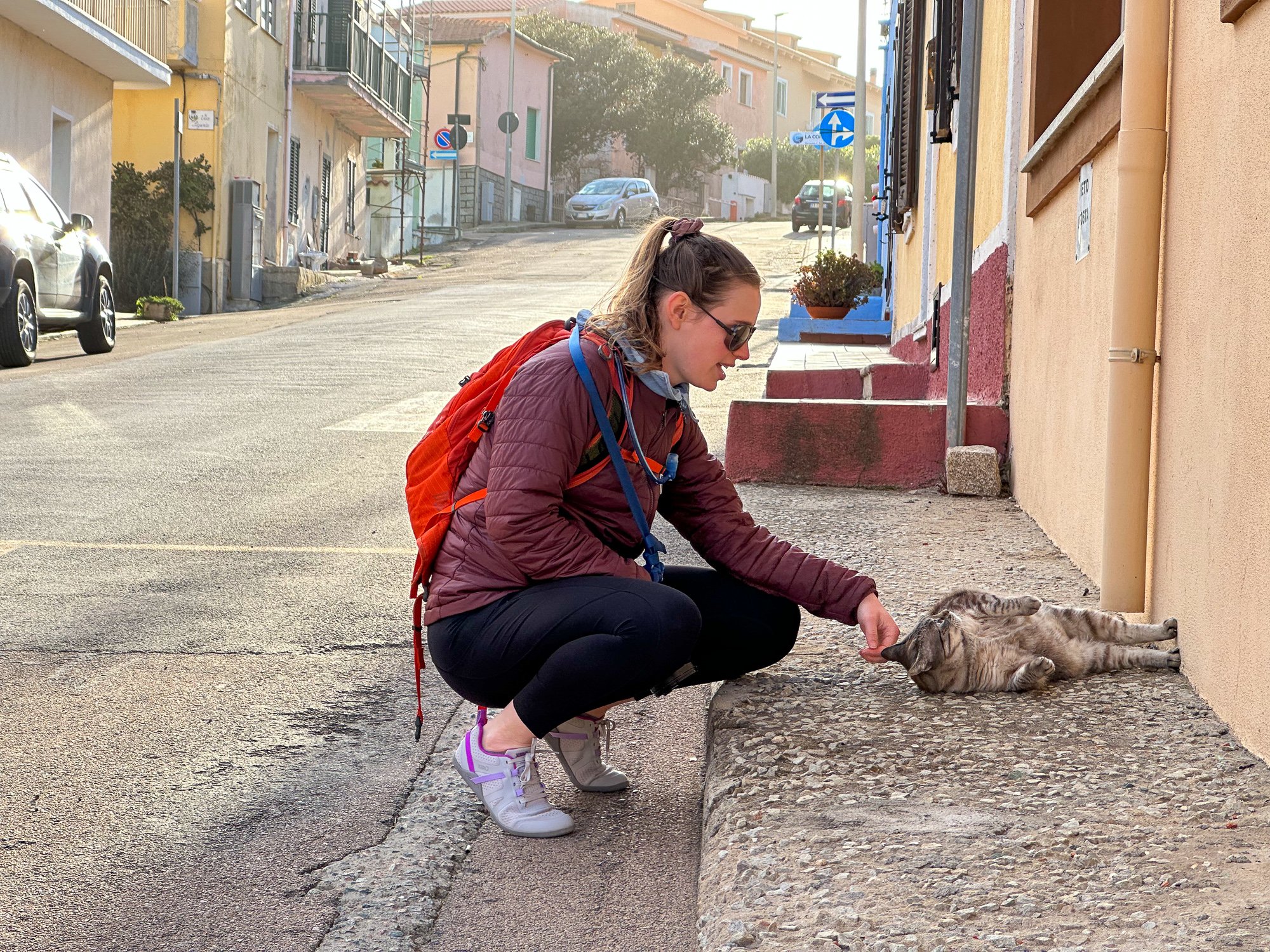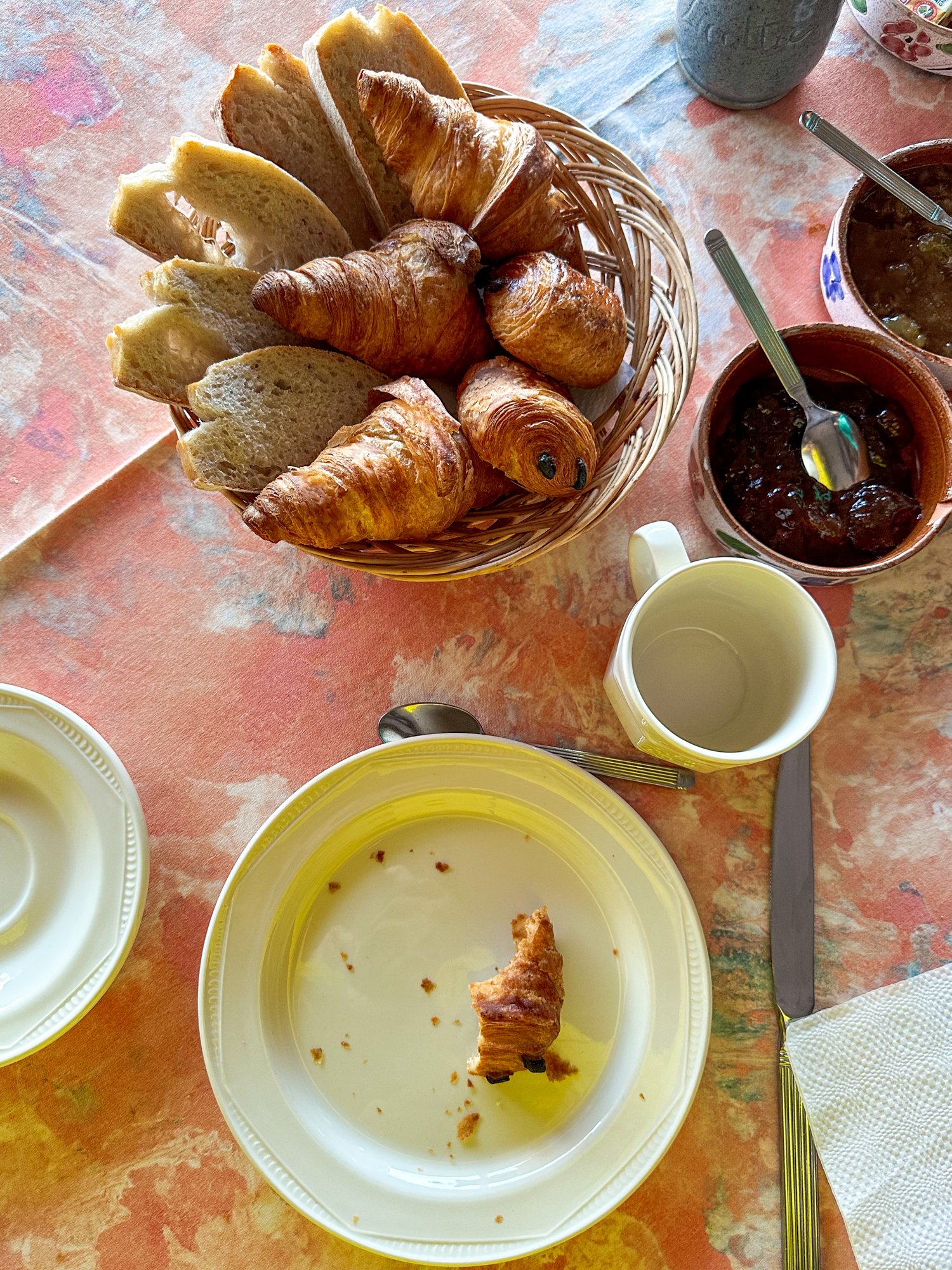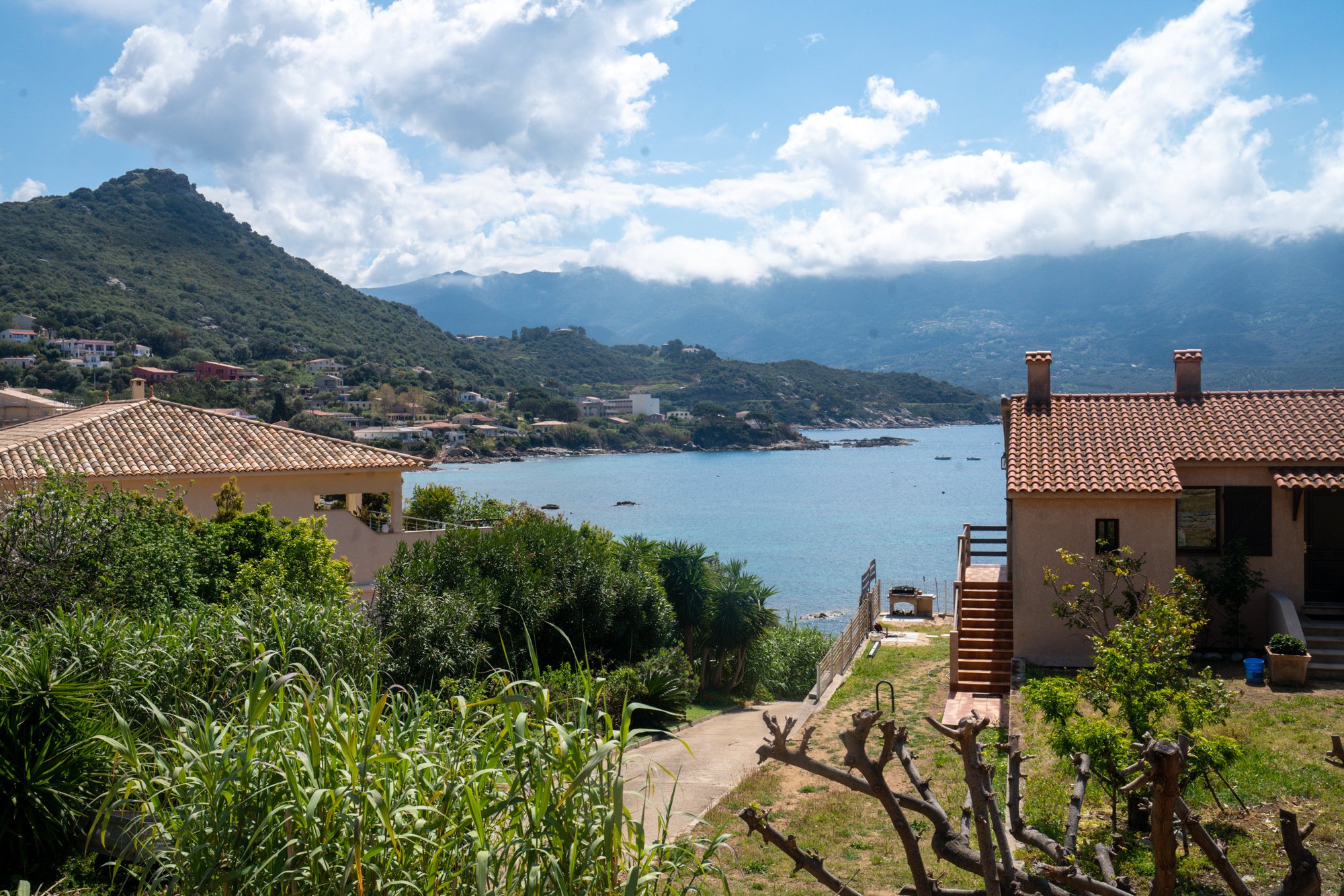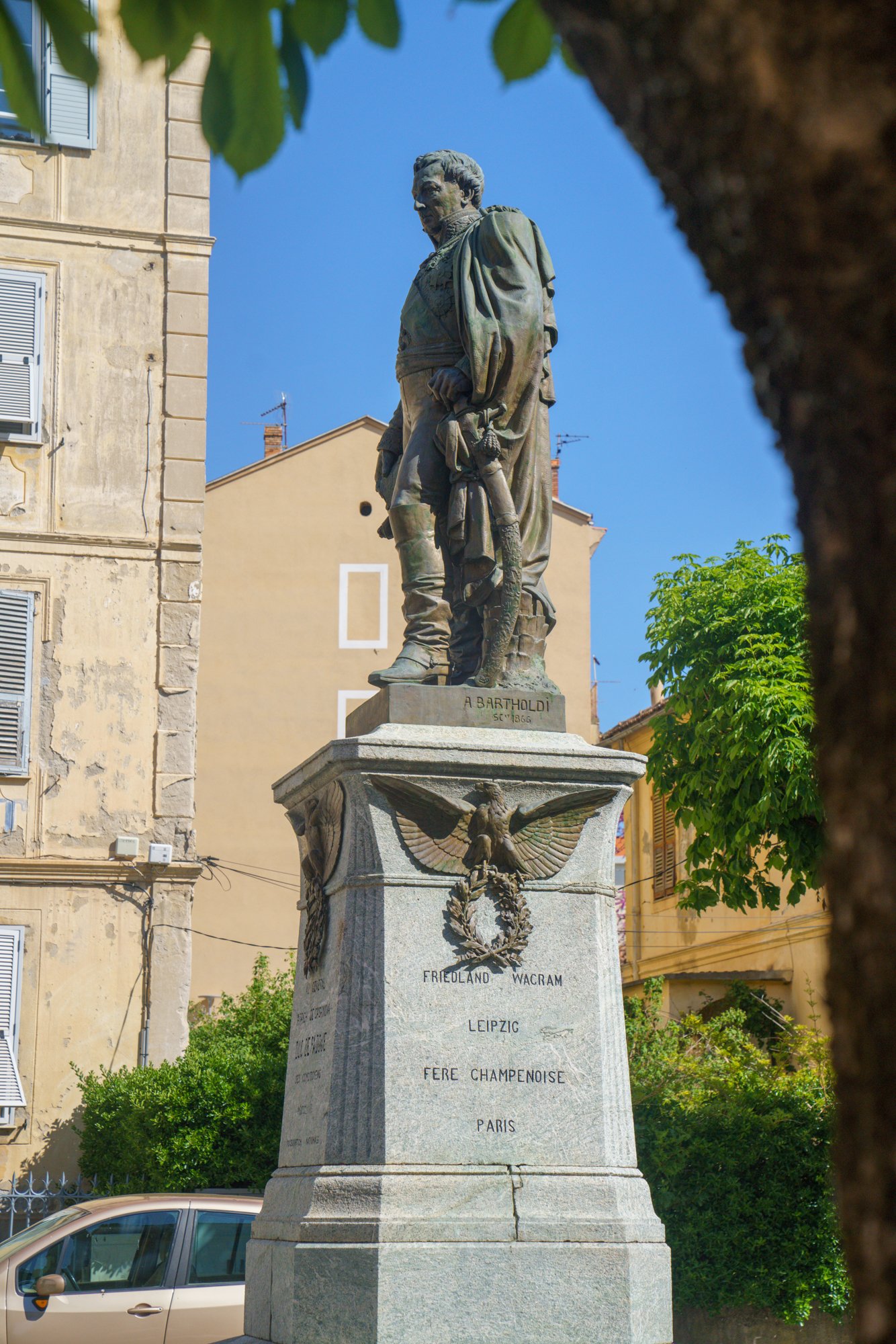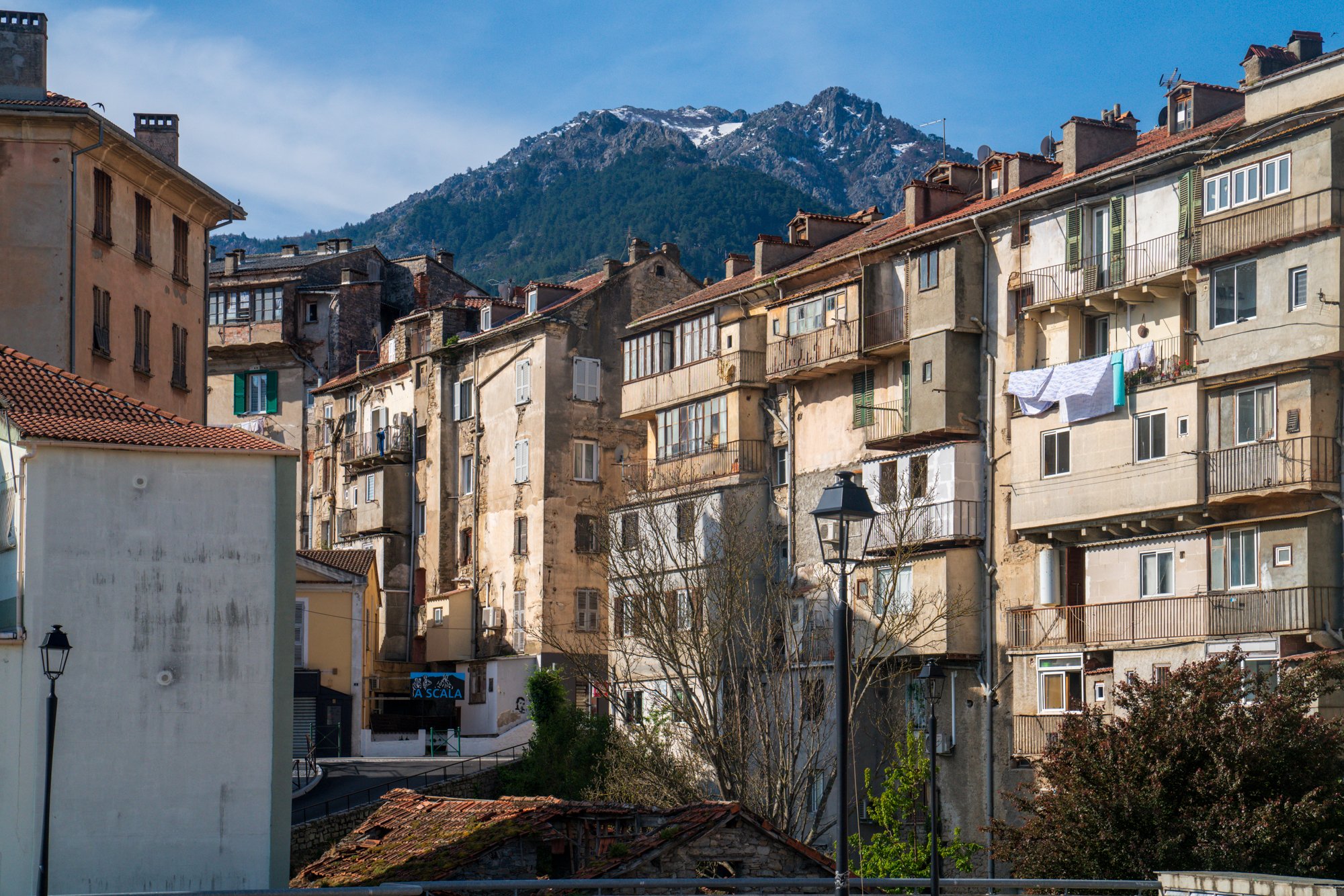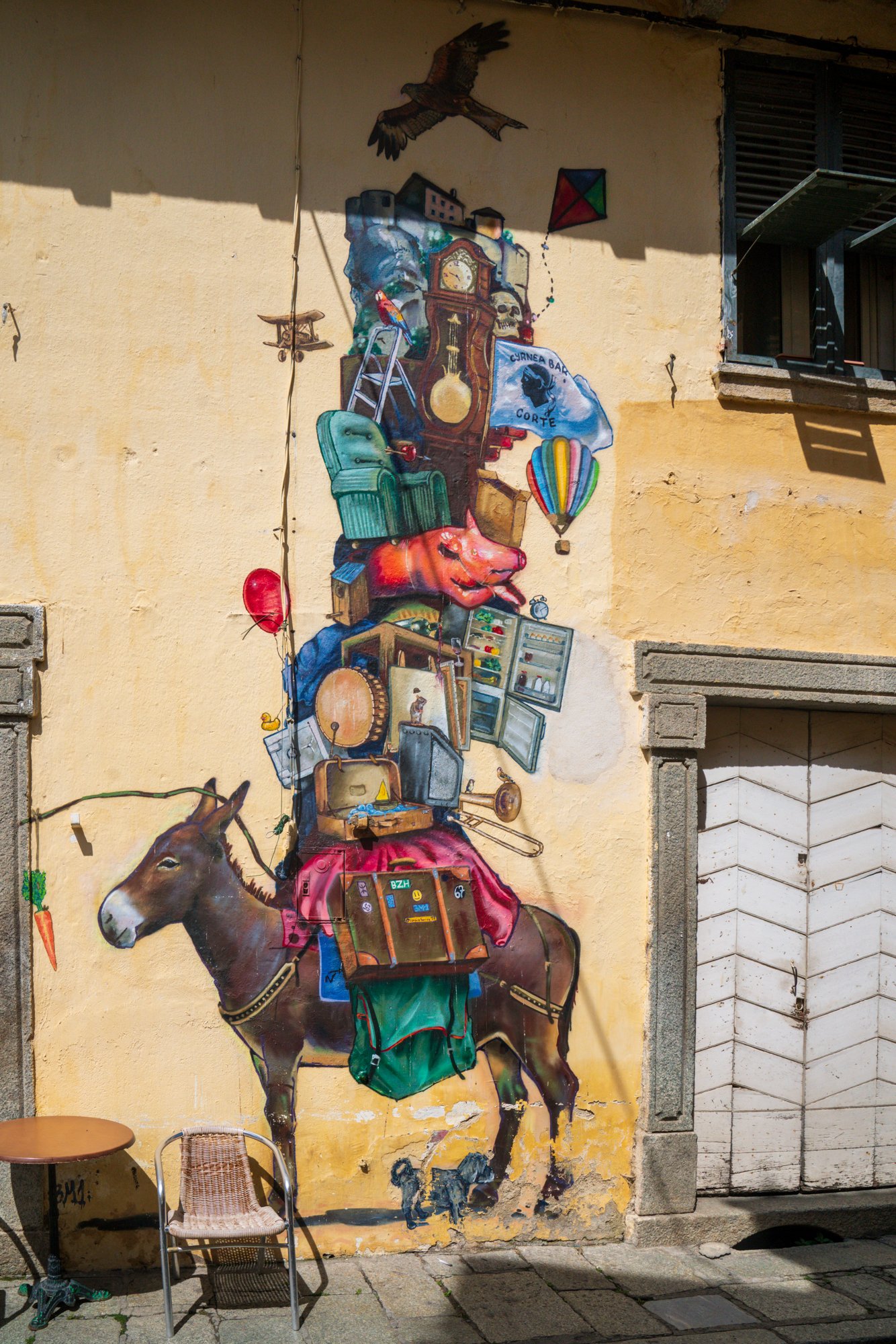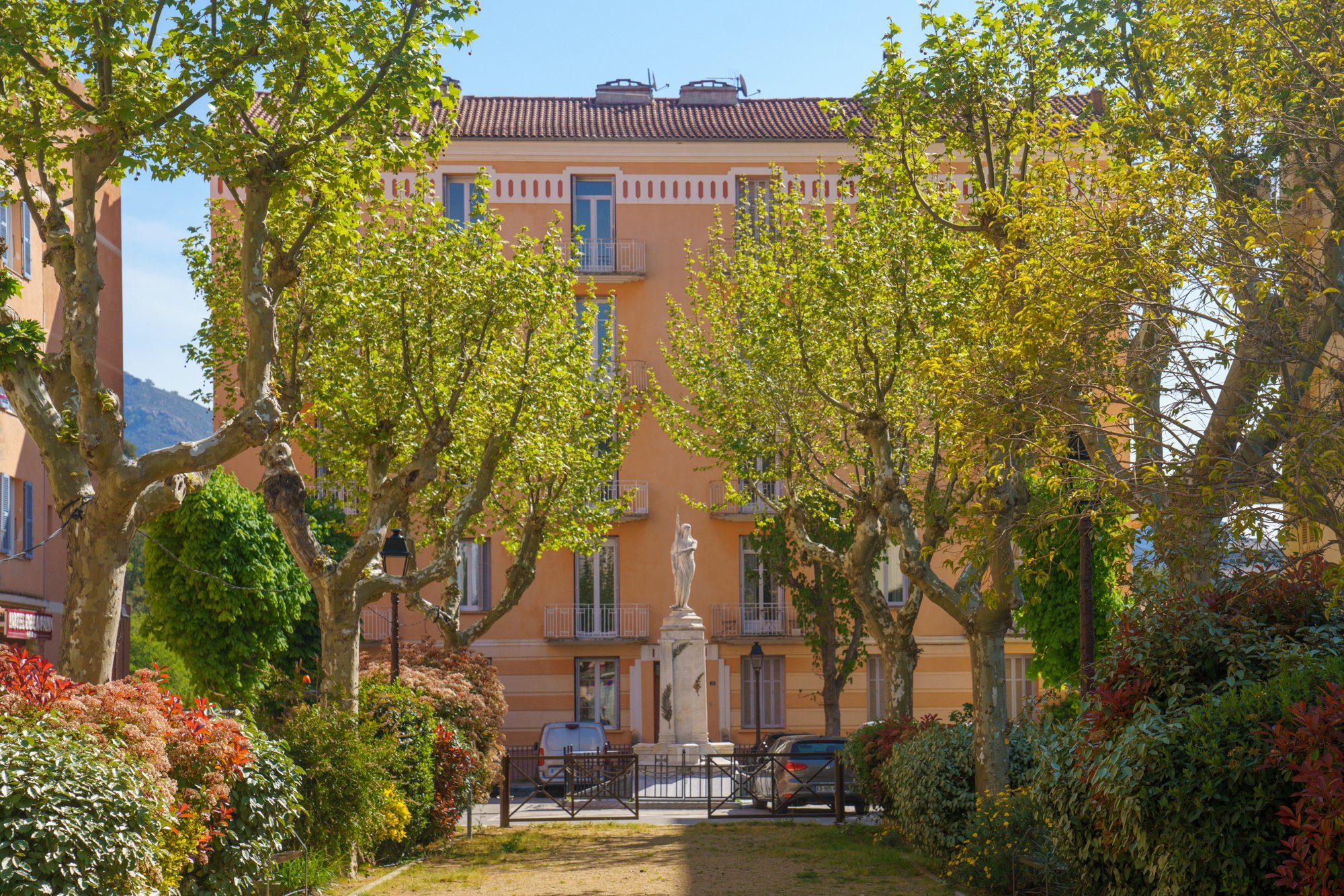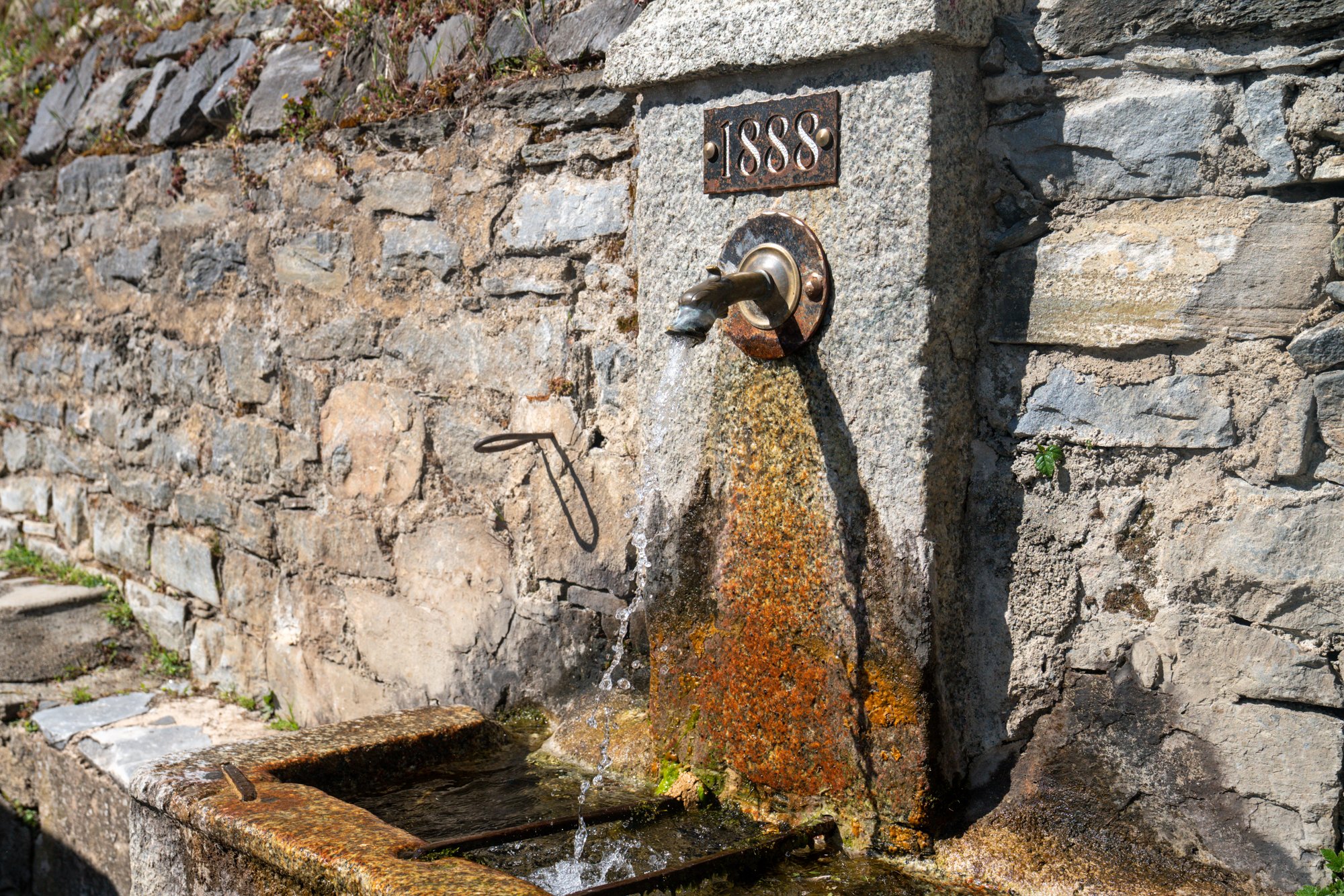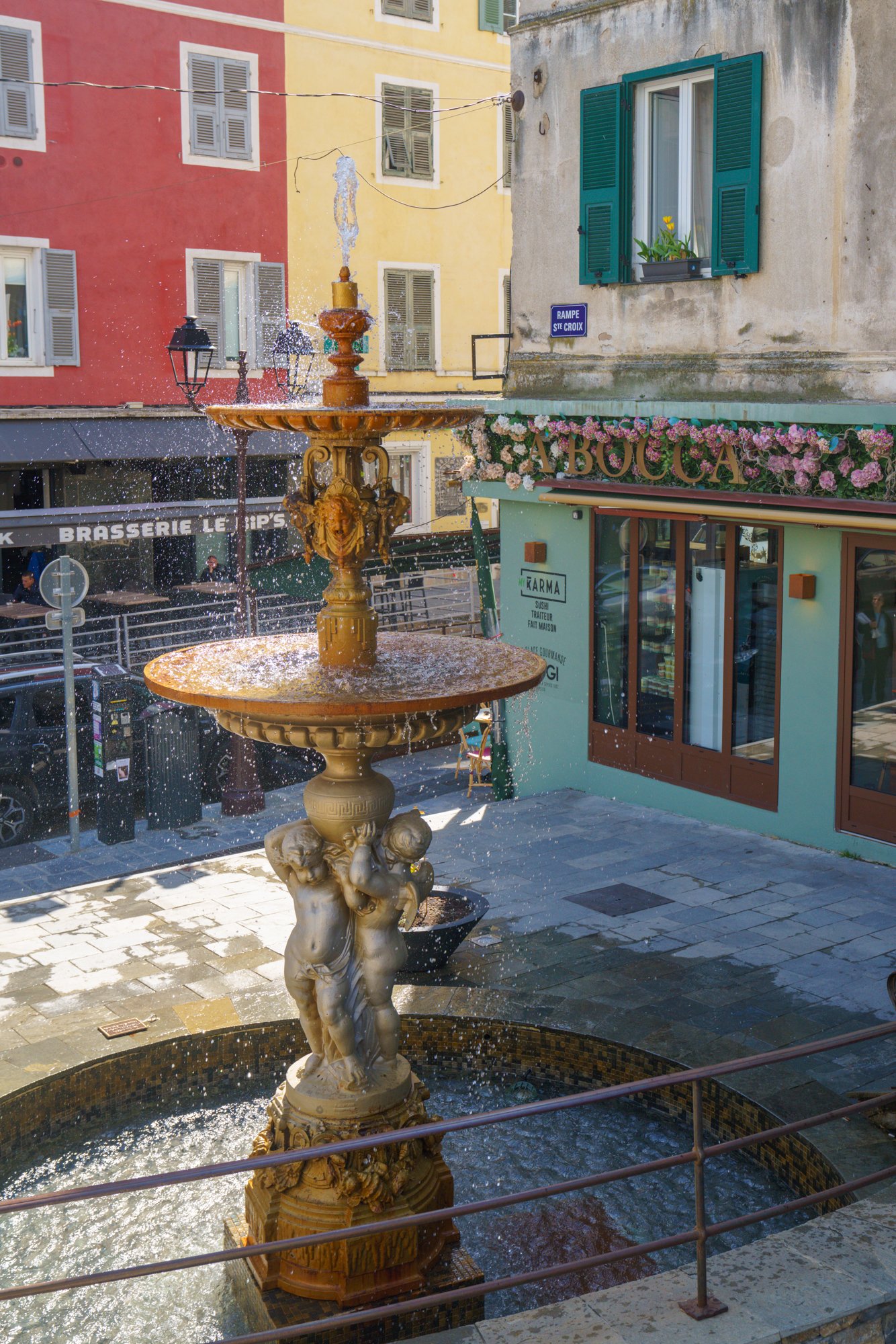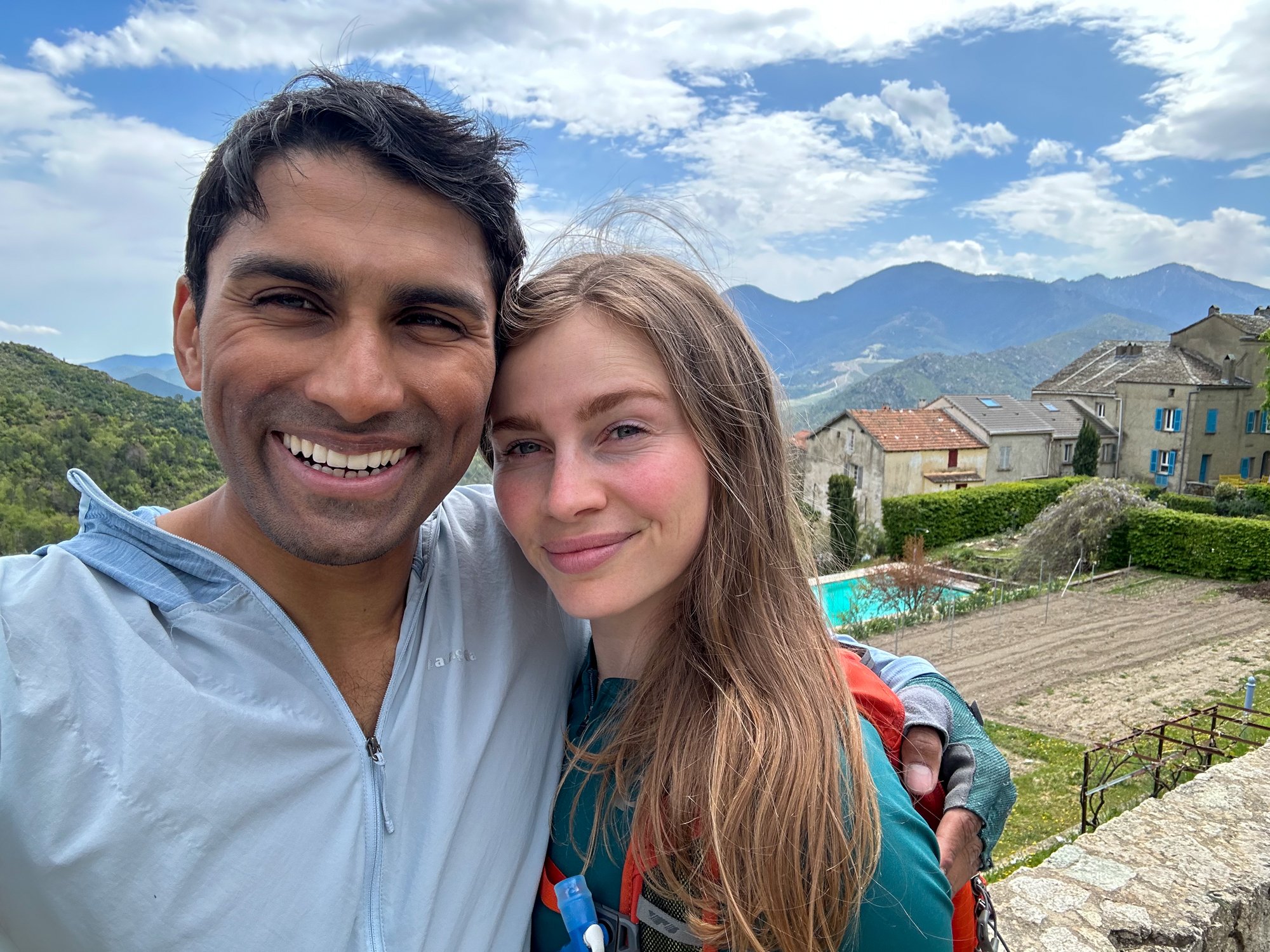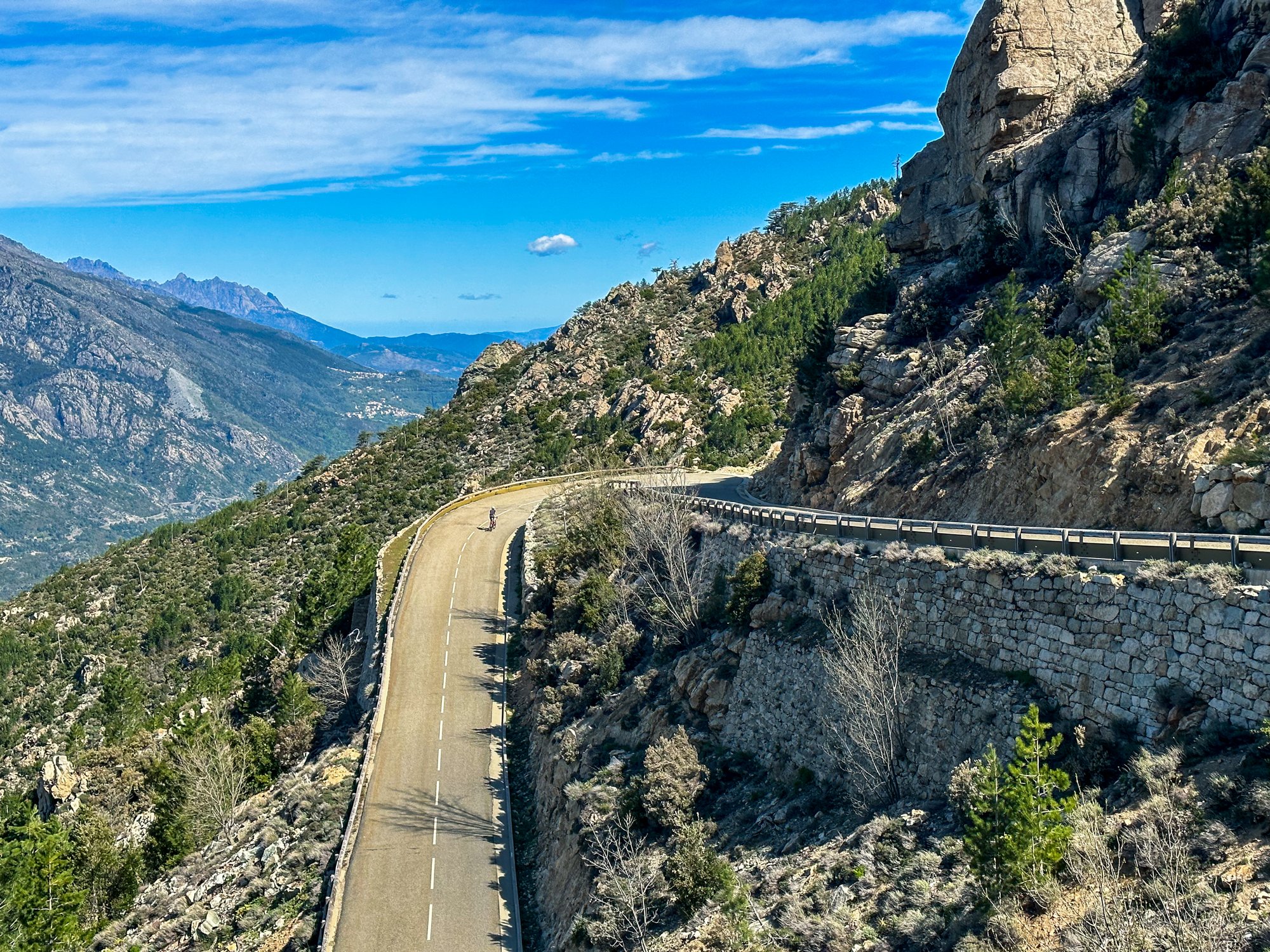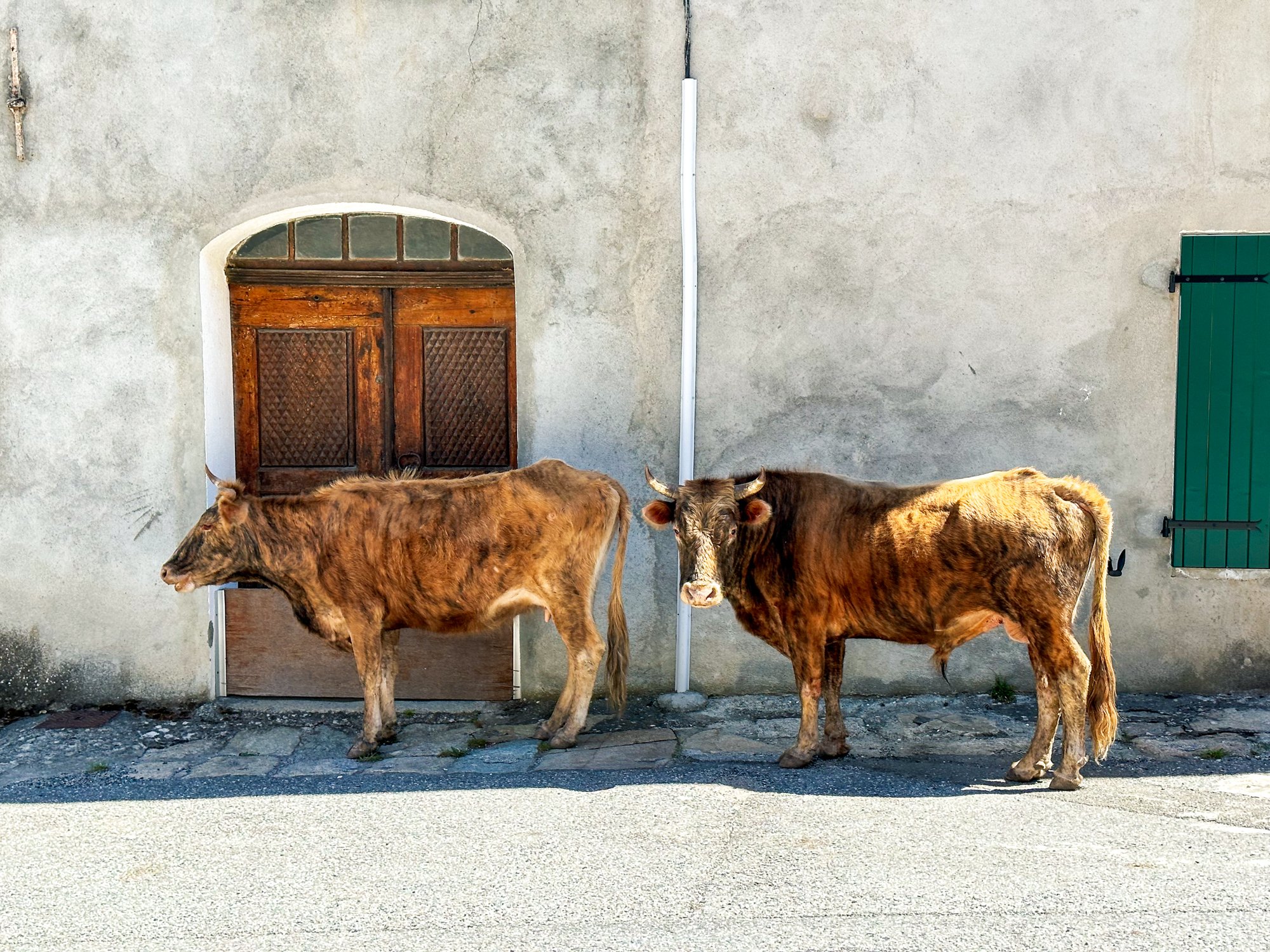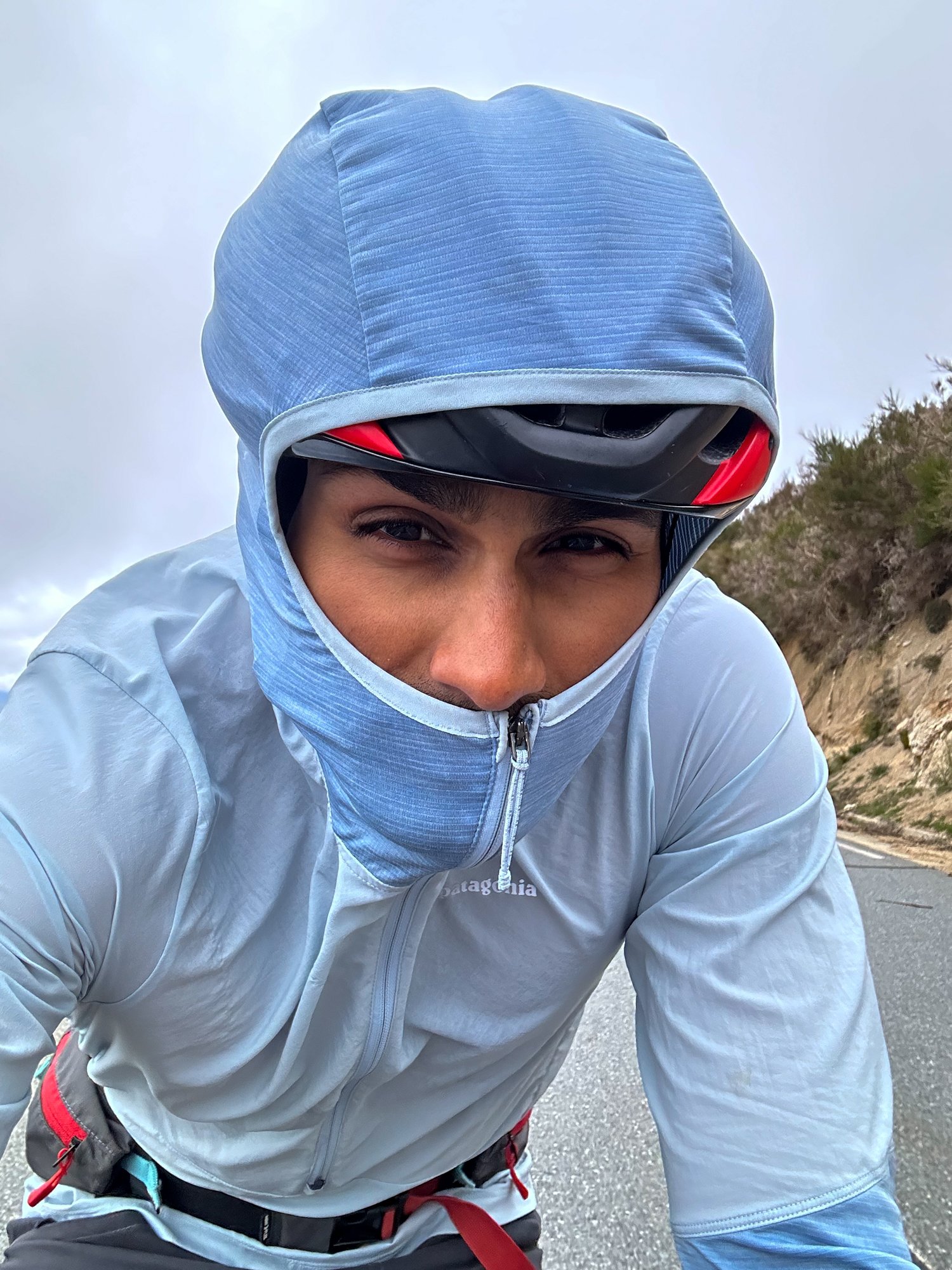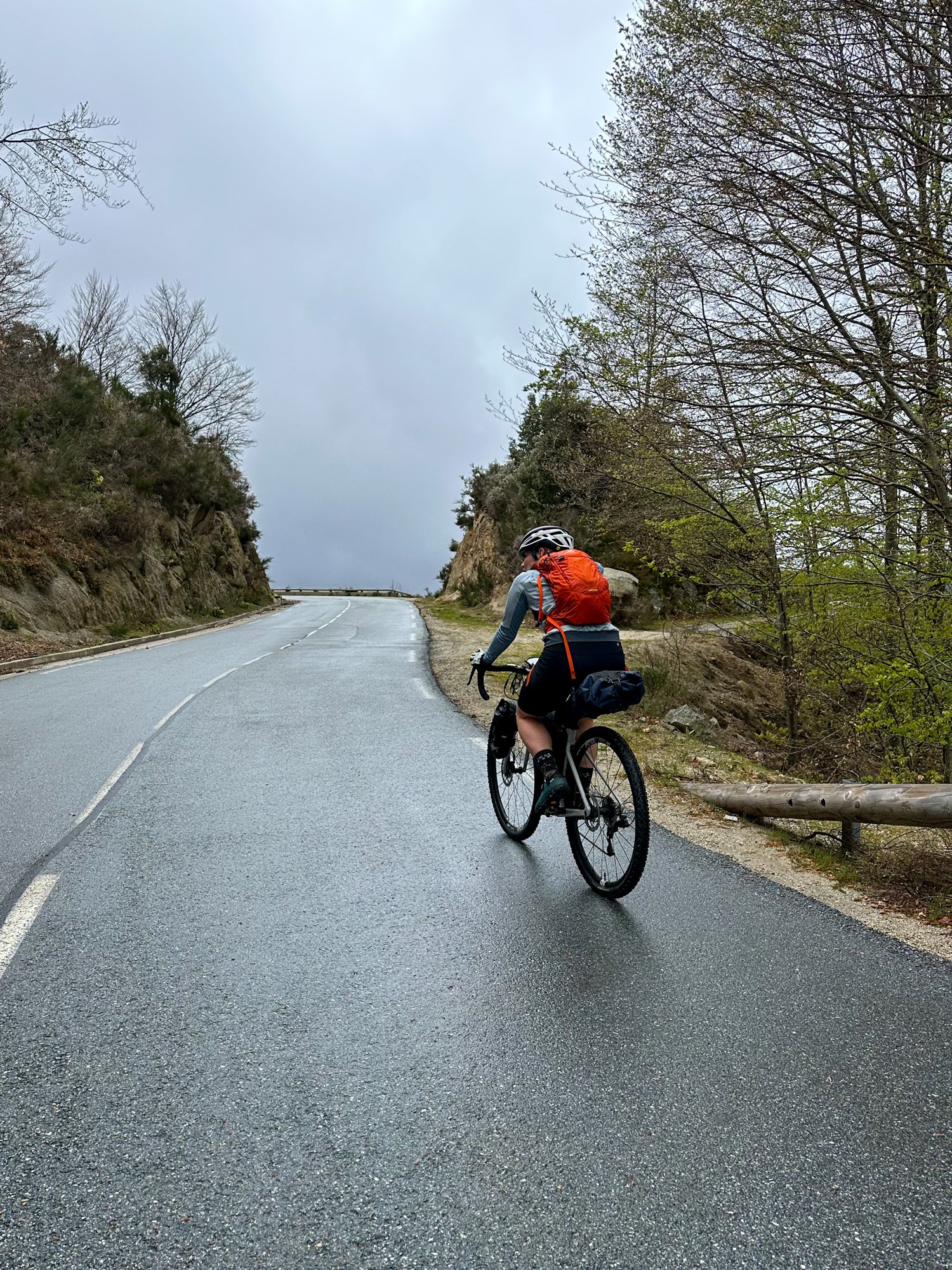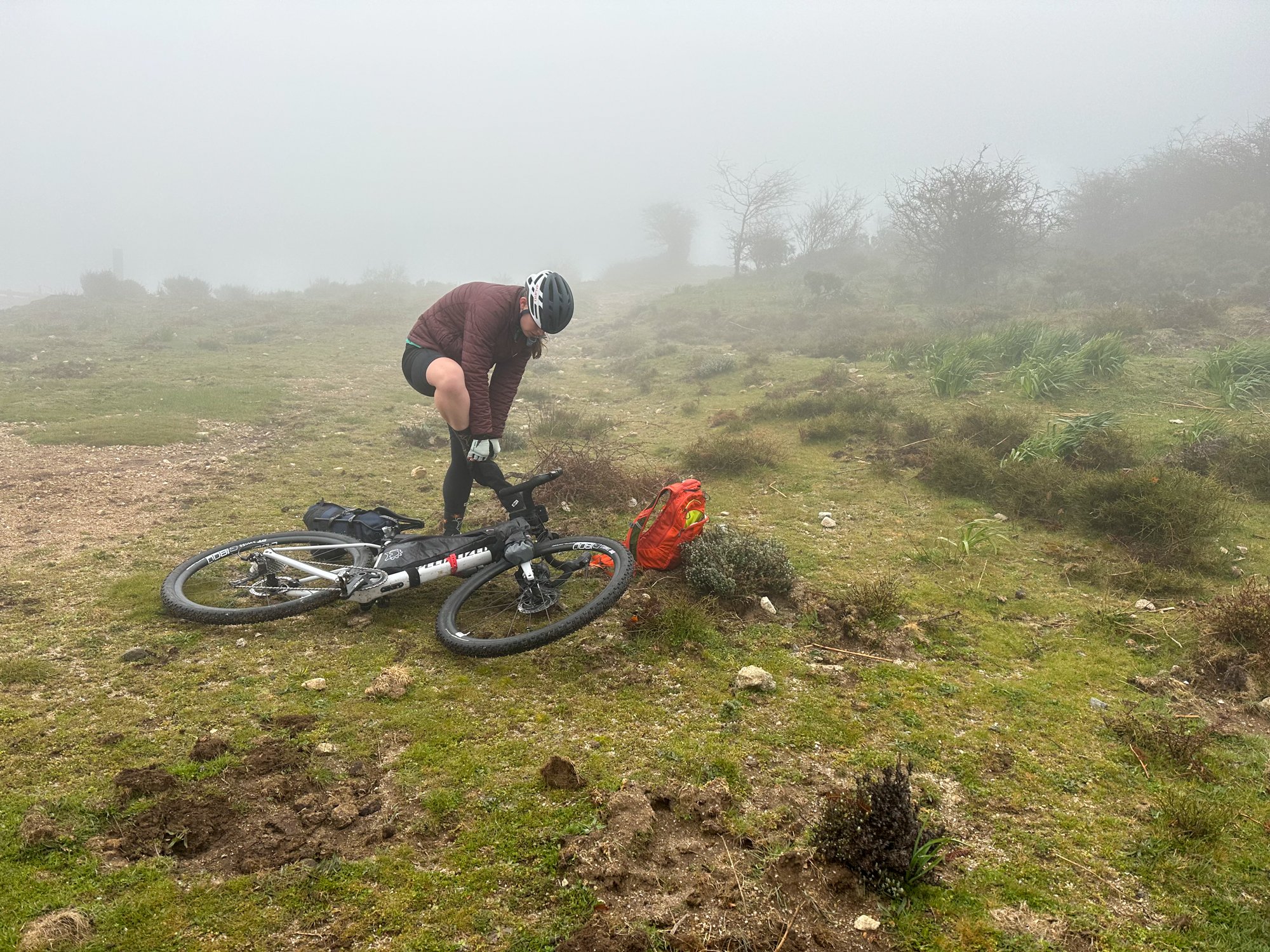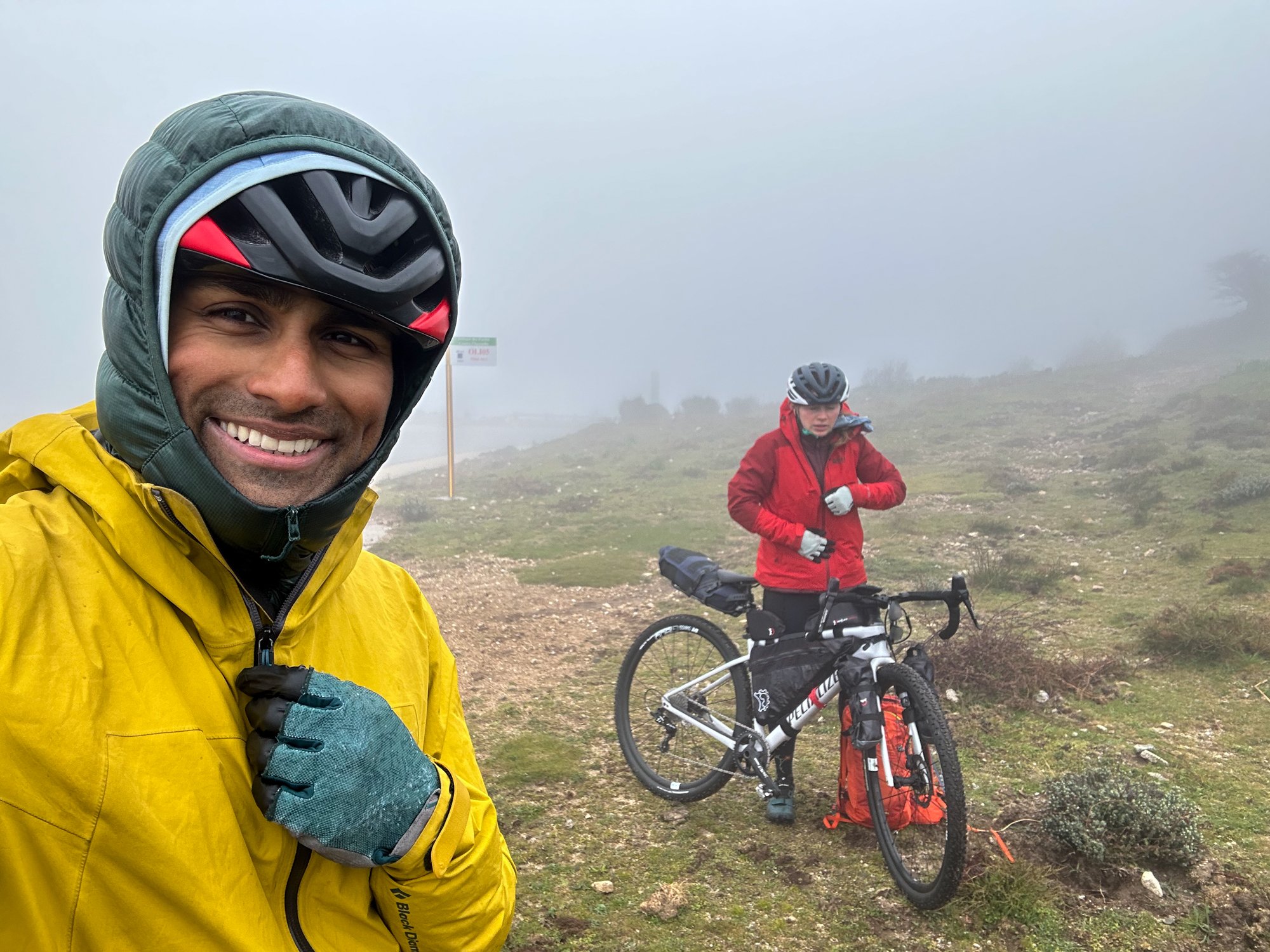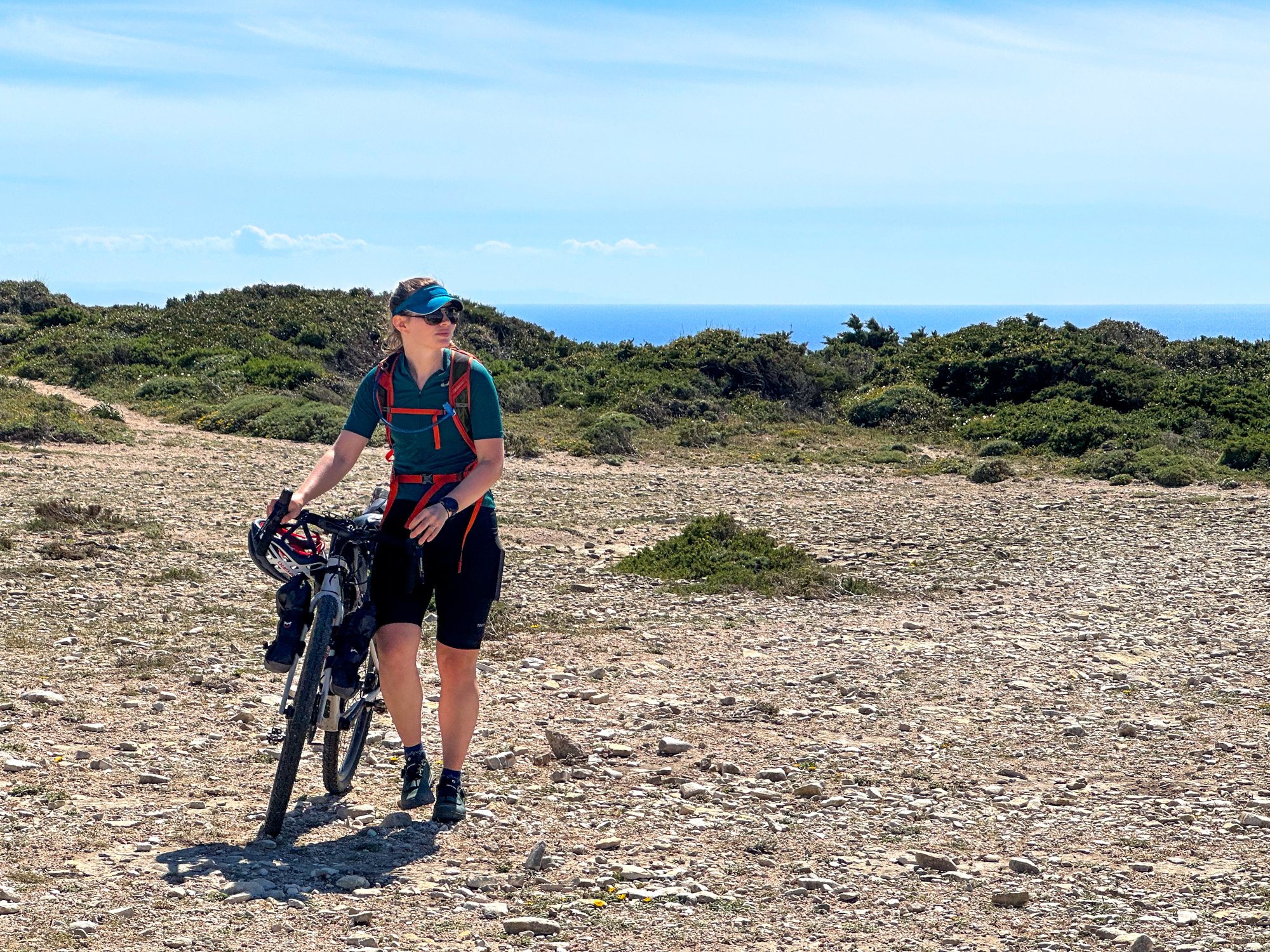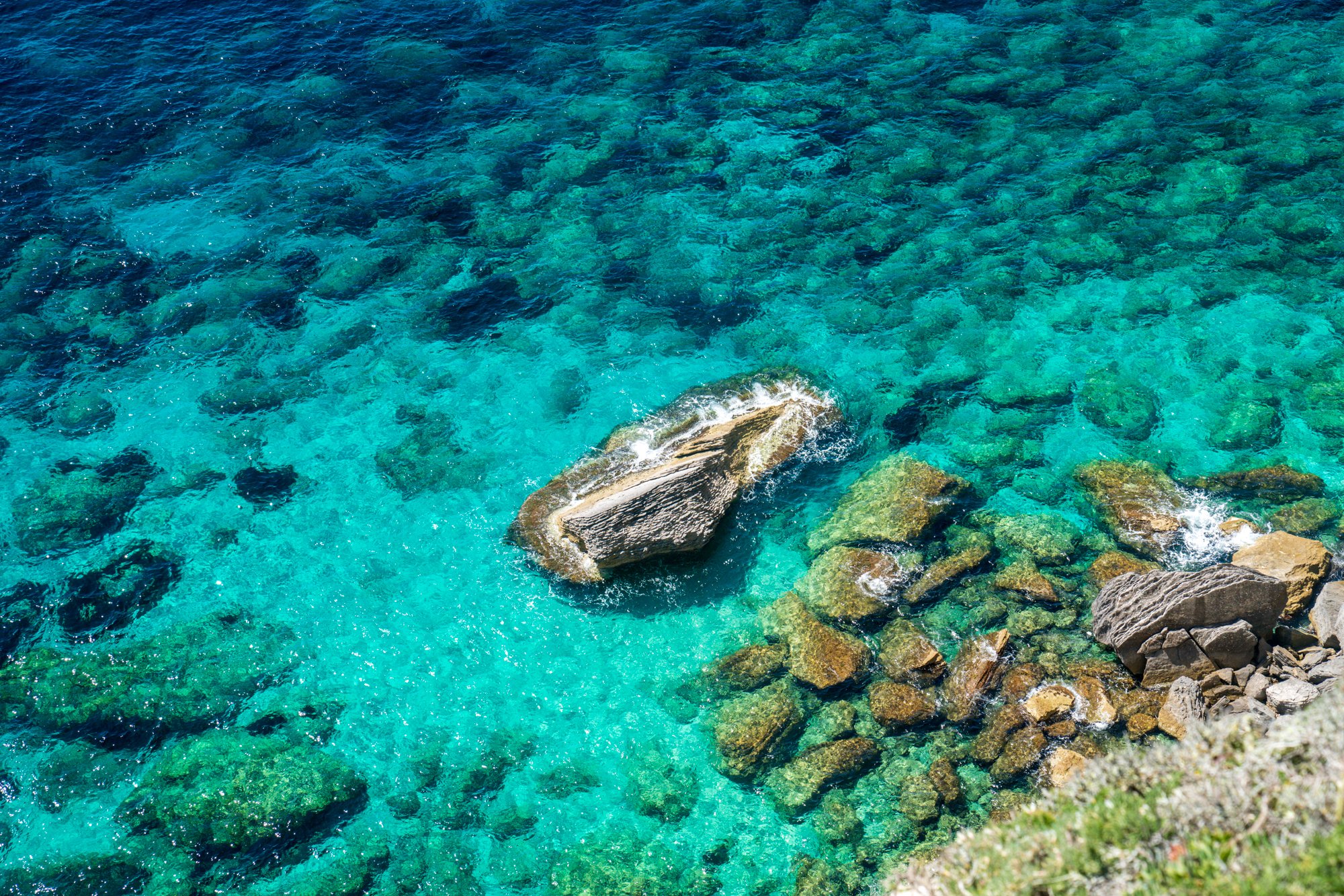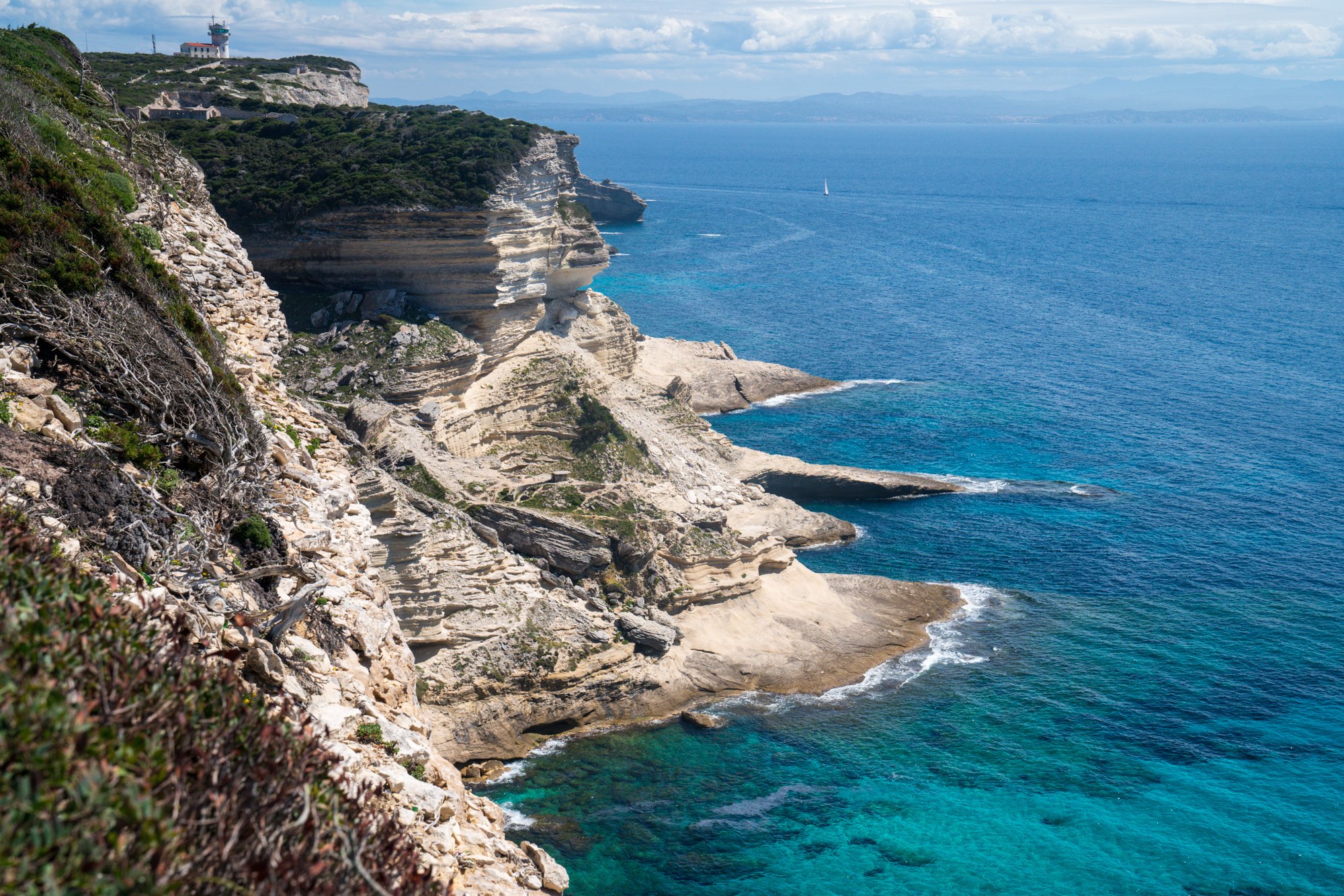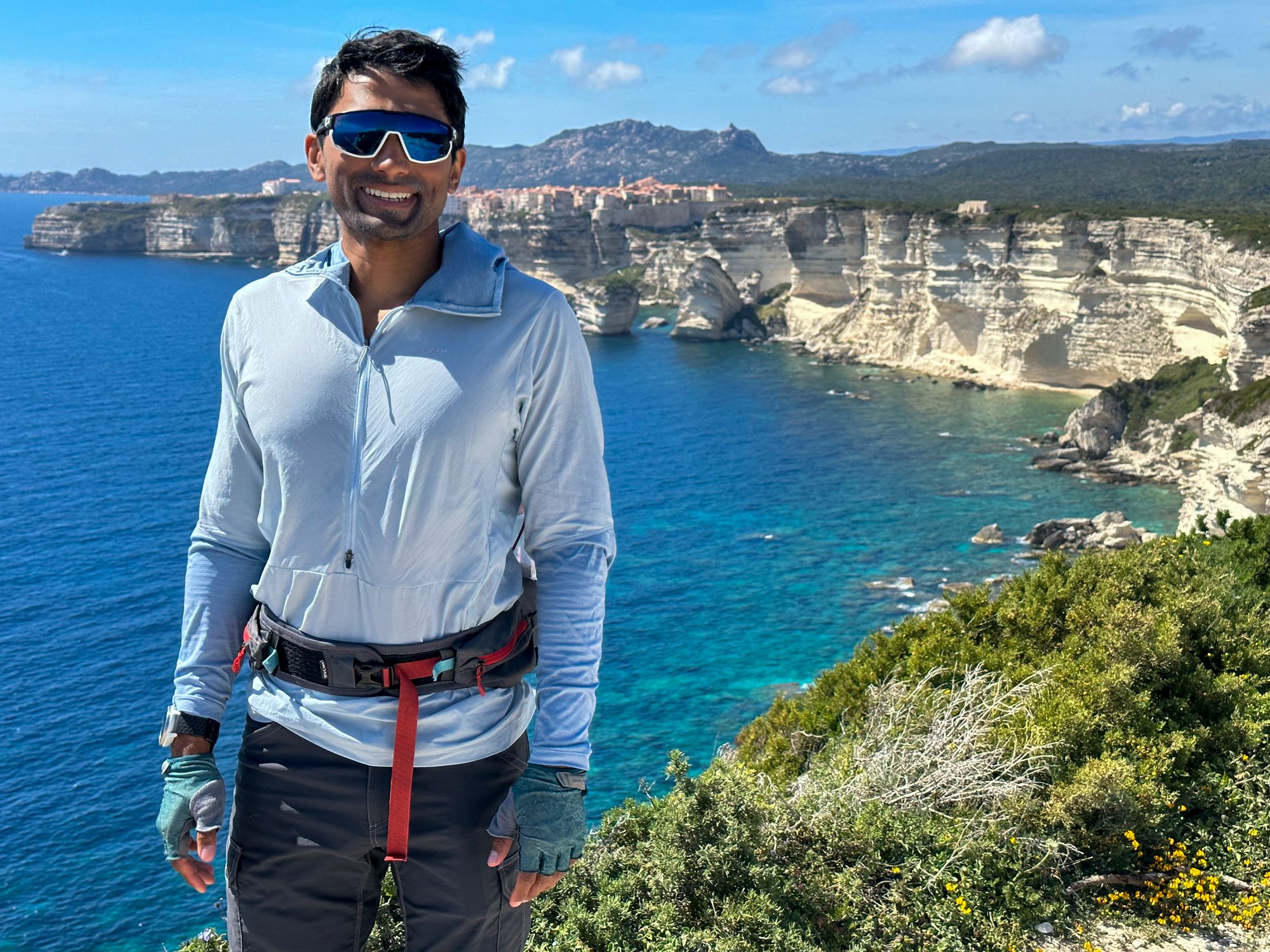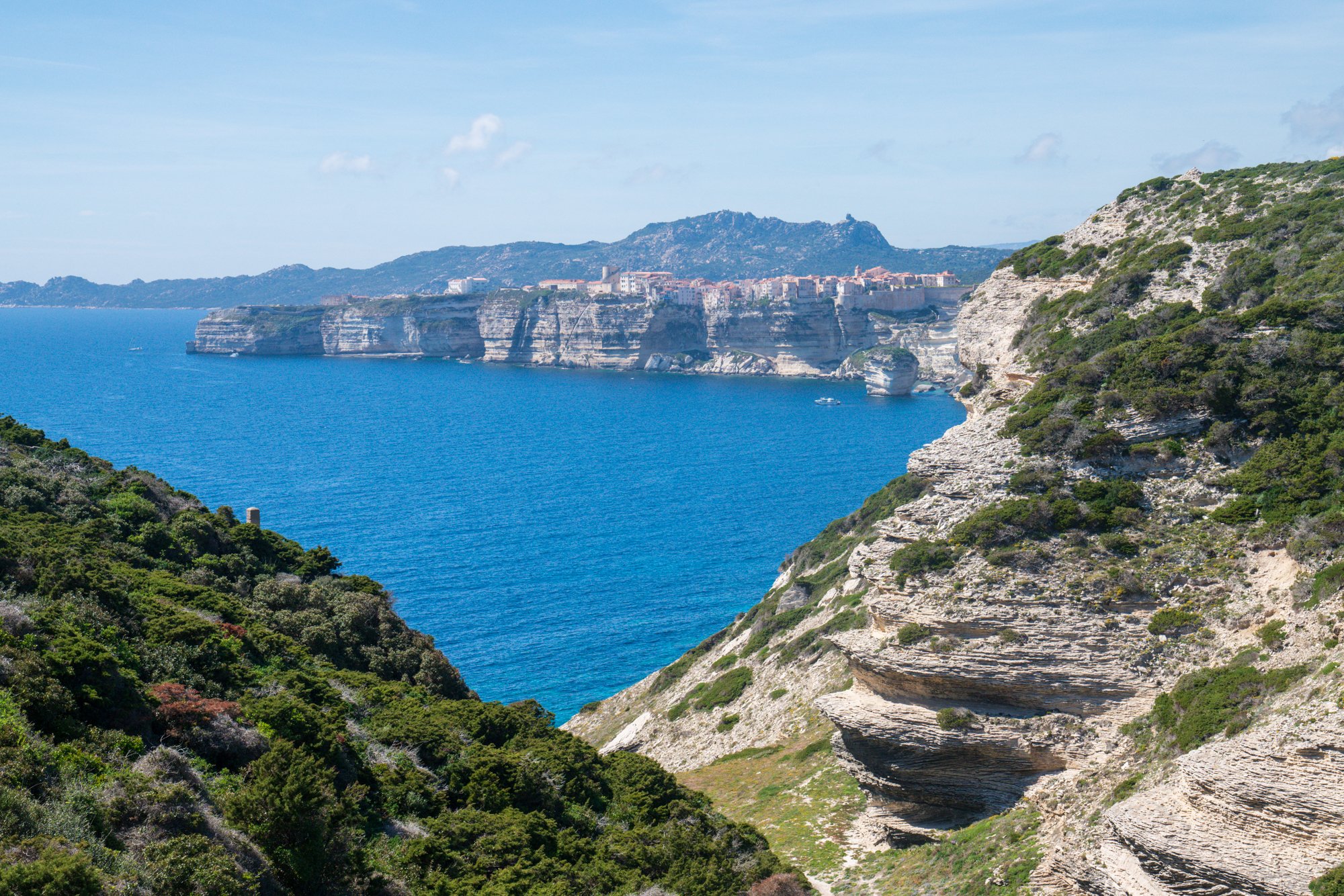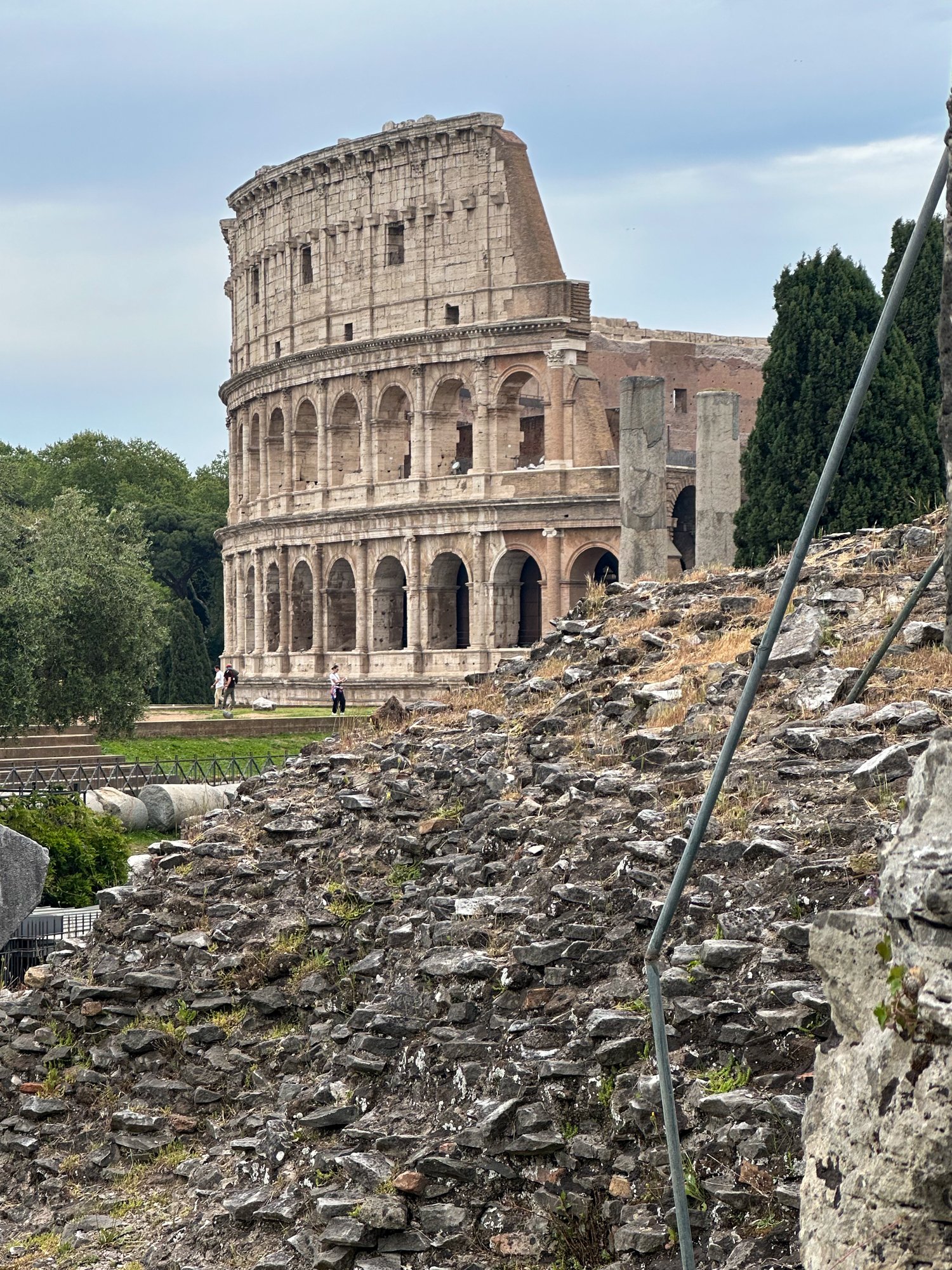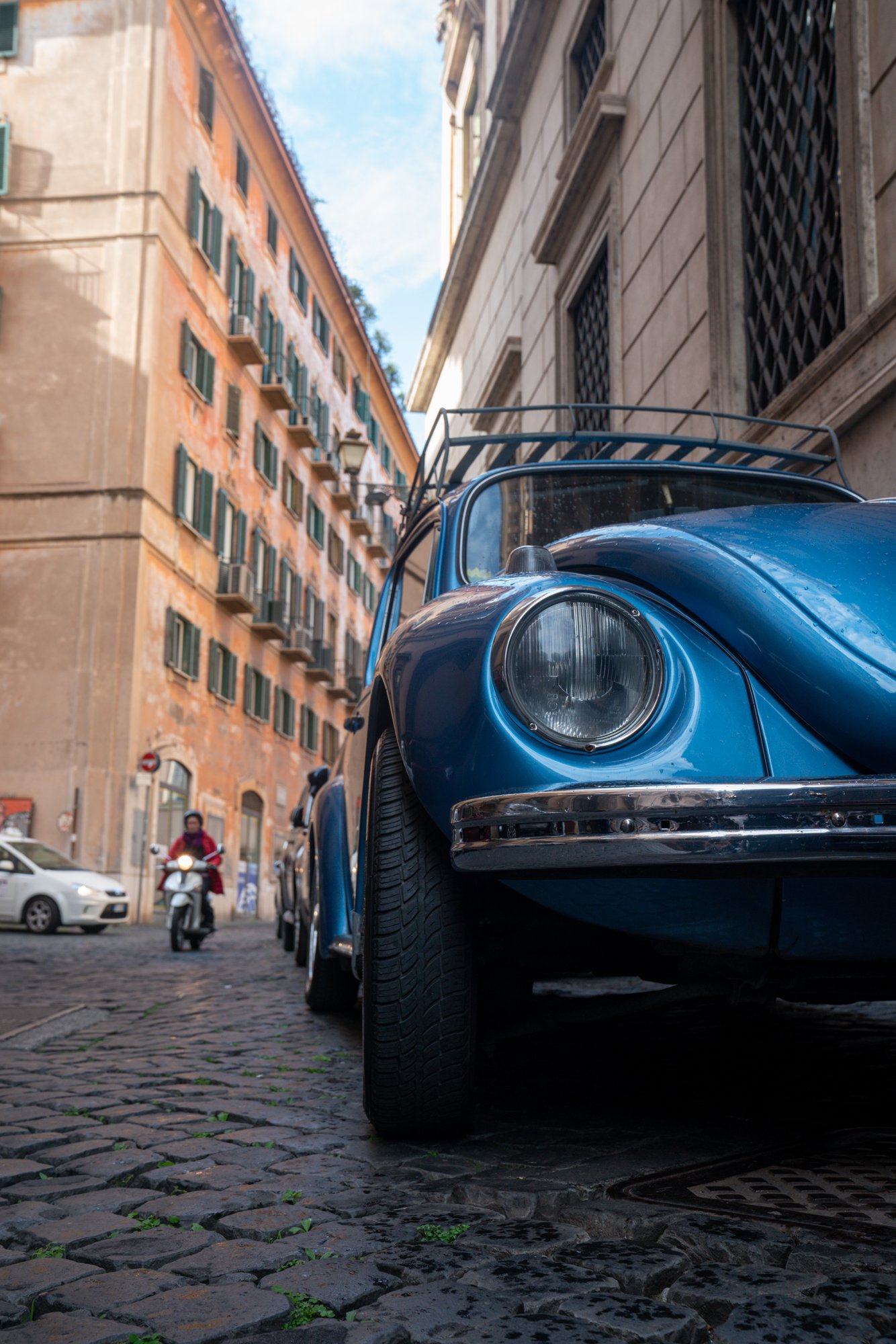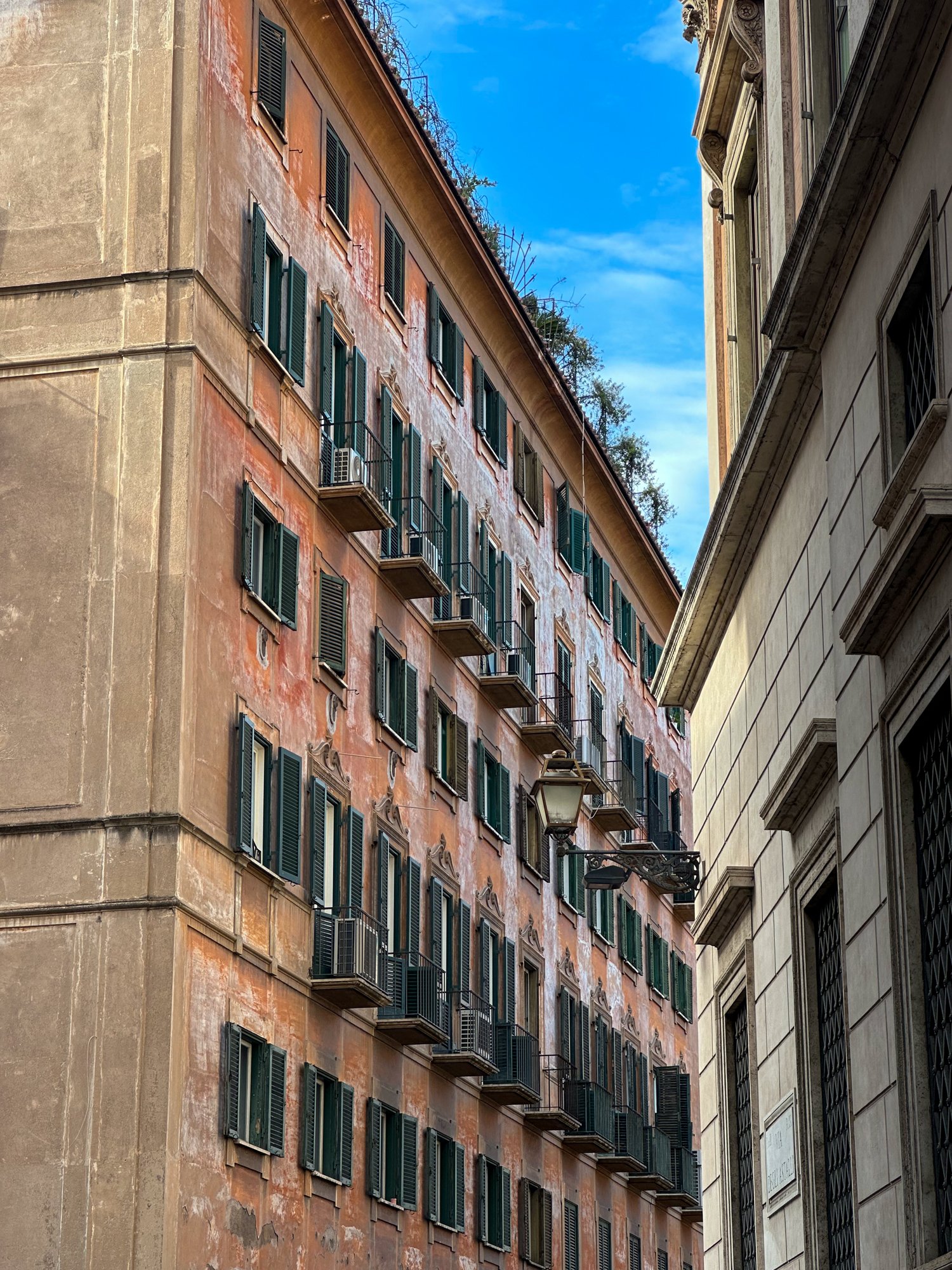CYCLING CORSICA AND SARDINIA
Three weeks of self-supported bike touring the jewels of the Mediterranean
For months, Leah and I were looking forward to trekking in Nepal’s Langtang Valley for our honeymoon. After Nepal suddenly mandated all tourists would need a guide, we lost interest. I also recently tore my ACL, which forced us to think about how we could have an adventure without hurting my knee. Just over a week before flying out, we began to consider Corsica as a destination. What followed was a frantic nine-day scramble to plan routes, arrange travel logistics, and pack for an entirely new activity neither of us had done before: self-supported bike touring.
SEATTLE → ISTANBUL → ROME
The days leading up to our trip were a frenzy. We scrambled to buy bike bags and turned to YouTube to demystify the art of bike disassembly. Until now, the most mechanical task we had attempted was simply removing the wheels. We carefully packed the fragmented pieces of our bikes with foam bricks, and hoped we’d know how to reassemble them once we landed.
Our decision to accept a one-hour layover in Istanbul proved to be a bad one: our flight out of Seattle was be delayed by over an hour. Leah was visibly stressed, worrying how this delay would affect our meticulously planned itinerary. I passed the ten hours on the flight stretching, pacing, and icing my knee to stave off the pain from cabin pressure-induced swelling. It had only been six weeks since tearing my ACL. I silently wondered if my body could handle the hundreds of miles of riding we committed ourselves to.
Once we arrived in Istanbul, we were relieved to see that the connecting flight to Rome was grounded until we boarded. An agent hustled us through the airport and I did my best to hobble along as my gait was still off. After a few tense moments wondering whether our luggage would also make it, we confirmed with an AirTag that the bikes were loaded onto the plane. We finally eased into our seats and released the tension we’d been carrying since leaving home. From where we sat, the most stressful part was over and we hadn’t even arrived.
It was late in the evening when we landed in Rome. As much as I would have loved to throw down some cacio e pepe, we immediately boarded a train heading north to Civitavecchia, a port town an hour north. Navigating transfers was complicated enough while being sleep deprived, but doing so while dragging an awkward piece of luggage onto small train cars, up and down narrow staircases, and squeezing ourselves into tiny elevators was a nightmare. Doing so while nursing a knee injury was hell.
We arrived to Civitavecchia on what felt like the last train of the night. We rolled our bags on the quiet street, wheels rattling furiously on sections of old cobblestone. After checking ourselves in to a hotel, we slipped back out into the night in a desperate search for something to eat. Reluctantly we decided our first meal in Italy had be at the only place open at this hour: sushi. I’m not sure if it was the hunger, but I thought it was one of the best sushi meals I’ve ever had.
CIVITAVECCHIA
Our overnight ferry to Sardinia wouldn’t leave until 10:30pm, so we had all day in Civitavecchia. We took turns laying out the fragments of our bicycles on the little floor space available to us. Fortunately, we were able to piece it all together.
We stepped out for a late lunch and had our first of many lessons in the riposo (the Italian word for siesta). Our dreams for an afternoon slice of pizza were thwarted when we arrived to find the shops in town closing up. Over some pasta we thought about how we should store our bike bags and other items we wouldn’t carry with us while pedaling.
Initially we planned to ask our hotel to hold the bags, but then realized we wouldn’t stay another night in Civitavecchia on the return. Just a few doors down, there was a bike shop that catered to a local road cycling crowd. If it was open, we hoped to ask for a very big favor.
Fortunately for us, Francesco, the owner of Cicli Scaccia Dal 1946 spoke perfect English and had no hesitation when saying yes to our request. I was quite surprised by his generosity and reiterated that he’d be holding two bike bags for almost three weeks. He didn’t flinch. We thanked him profusely.
Leah and I nearly danced our way back to the hotel room, giddy at the thought that a big unknown of our trip had just been resolved. Francesco later admired our bikes, both Specialized Diverge frames with gravel tires. He hadn’t ever been to Corsica and asked that we take lots of photos to share with him. After saying goodbye and thanking him again, Leah and I took our fully loaded bikes and rode for a few minutes around the town as the sun was setting. We wanted to adjust ourselves to the weight and also wanted the validation that we didn’t screw up the reassembly of our bikes. The reality of pushing a laden bike for hundreds of miles began to sink in on those practice pedals, but we were committed.
Our pizza dreams would finally come true at Pizza LE, where we’d have our last meal before boarding the ferry. We looked obviously lost staring up at the expansive, hand-scribbled menu, so the pizzaiolo’s son came over to help in his broken English. He guided us through and Leah asked what was available, hoping to simplify the choices by selecting from whatever was pre-made (like a typical pizzeria in the US). He responded “ah-bella-bull? No, we don’t have ah-bella-bull. We make everything you want!”
By the time we seated ourselves, I had forgotten what we ordered, but trusted we were in good hands. What arrived on our plate was some of the most incredible pizza I’ve tasted, entirely unlike what I was used to growing up in New York City. Leah and I stared at each other in amazement, incredulous that something so simple could taste so good. This is what I’d been hearing my entire life about Italian food, and I finally knew what everyone had been raving about. When it was time to pay the bill, we was again astounded that the total cost was only €10. We thanked the son for his help and I dropped a €5 note in the tip jar, to which he responded by holding his hands in prayer and pleading “No….no, no, no! Grazie!”
Back at the hotel, we were all set to check out when Leah had a small gear mishap. She forgot to close the top of her CamelBak, causing some water to leak into her backpack and render her phone charger useless. After quickly cleaning up, we hurried to catch the ferry in the dark. Despite a few minor setbacks along the way, Leah led us smoothly through the night and we boarded the ferry. During the passport check, we had a chat with two security guards who, upon learning it was our honeymoon, excitedly taught us a new word: luna di miele.
We yelled “Ciao!” to them and loaded our bikes onto the massive ship headed for Sardinia. We fully expected to bring our bikes into the cabin we had booked, but were instructed to keep our bikes with the hundreds of cars and trucks that were filling up the cavernous garage. It was our first time ever being separated from our bikes, so we were paranoid. With only a frayed rope to keep our bikes upright, we headed up to our private cabin with whatever bike bags we could detach easily. It was a simple room with a shower, but it was plenty. Unfortunately, I didn’t expect us to sleep much though since we’d be docking in the town of Olbia at 6am.
OLBIA → LA MADDALENA
We were awakened by the crackling of the loudspeaker at 6am. The recording, piped in to every cabin, announced in Italian, French, and English that we’d better vacate our rooms as we’d be arriving any minute. Both of us would’ve slept another hour, especially if we had known that we wouldn’t be docking until after 7am. We hurried to the top deck to catch the first sightings of Sardinia in the pre-dawn glow, marveling at the hills of stacked boulders dotting the coastline.
While we waited for the ferry to let us off in the port of Olbia, Leah noted that nearly 80% of the passengers were single men. We guessed they were likely truck drivers supplying goods from the mainland. Unlike us, nearly all of them made the overnight journey by simply sitting in a chair in the lounge area (about ten times less expensive than a private room). They looked even more tired than I did.
After about a hundred cars and trucks rumbled off the ship, we rode out into the bright morning light whooping and cheering. We were starting the route we’d been dreaming about every hour for the past week. After a few hundred miles, we’d be returning back to this port to close the loop. At the moment though, we had our minds set on breakfast at a cafe just ten minutes away. We placed our order with the few words we knew, the most critical among them being “due cappuccino, per favore.” We’d also get our first lesson in the Italian cornetto, which had little to do with a croissant despite the appearance. In addition to being sweeter, having a more cake-like chew and brioche bite, the server also asked if I wanted it filled with cream or marmalade (something I could never imagine being asked in Paris).
After taking the last tiramisu they had, we re-mounted our bikes to begin in earnest. We pointed ourselves east, away from Olbia and the car traffic that was slowly building. With each passing mile, the road grew quieter and and the surrounding hills grew taller. We were taking the scenic route, which meant more miles in our climbing gears but we were in no hurry.
During the first hour, Leah remarked at how the bike felt heavy on the hills but I knew she’d be used to it in a few days. We stopped every few minutes to admire the calm waters in the countless bays. The sun was warm and bright, maybe a little too much for me, but the water would still be too cold for casual swimming for at least another month.
As tired as I was from three consecutive nights of poor sleep, the cycling didn’t bother my legs. I wore a DonJoy brace in my injured knee to protect my knee from further damage but I didn’t think much about it. Mostly I thought about how raw and dry my eyes felt from the sunshine and lack of sleep.
As we crested our first big climb, the rounded hills of boulders gave way to granite pinnacles. We found ourselves in the small mountain village of San Pantaleo. The streets seemed to tell us to slow down and whisper, like everyone in town was in the middle of a nap. The humming of our bike wheels were the only sounds on the main road, another reminder that we were in the early shoulder season. We were happy to see the the gelato shop we’d been daydreaming about for the last hour still open. Within seconds of finishing our first scoops of pistachio, we rushed back for another round. It was intensely flavorful and incredibly light. We would’ve gone for thirds but figured a proper meal was in order.
We biked around the entire village trying to find places to eat. It seemed the places on Google Maps were no longer open or hadn’t yet opened for the season. We wandered the narrow streets until settling on a trattoria where we’d get relief from the sun over a plate of for linguine pasta alle vongole. For the first time, we made the a mistake we’d repeat nearly every day: eating a large meal in the middle of a riding day.
Fortunately, the hardest riding was behind us. We descended and hugged the coast for the rest of the ride. At the town of Cannigione we found a rocky pier where Leah took her bike shoes off to test the water, confirming that it was indeed too cold despite looking so inviting. We appreciated the weather even more knowing we left a streak of rainy weather behind in Seattle.
Our ride would end in Palau, where we’d board yet another a ferry to take us to the island of La Maddalena, situated in an archipelago off of northeastern Sardinia. We boarded three minutes before it would depart, scrambling to purchase tickets to avoid waiting another half hour. Although we were in no hurry, we were hungry again after taking random breaks on unnamed beaches along the road. For a moment we forgot about our stomachs and eagerly watched with each passing minute as the hillside of La Maddalena revealed the patchwork of small houses painted in colors of champagne, coral, and dusty rose.
We checked into our hotel and were told that the bikes would need to stay on the rooftop. It was a bit annoying, but I was glad we had a small cable lock for peace of mind. In the room, Leah immediately picked up on the fact that the air conditioning wasn’t working. We were told by the front desk that Italians still needed the heat to be on given the cooler nights, and the HVAC system wouldn’t switch over for another few weeks.
Both of us expected the town to be far more touristy. Instead of avoiding guided walking groups, we were dodging small European-sized cars zipping uphill through the narrow streets. To our surprise though, nearly every restaurant seemed to have a preference for American classic rock. Some of that influence may be a result of the 35-year presence of American NATO troops. The nuclear submarines and the nearly 2,500 US military personnel and family members were vacated in 2006 when local concerns over an environmental disaster so close to a national park were finally taken seriously.
After dinner of pizza, we stopped by a supermarket just minutes before closing to stock up tomorrow’s ride. We’d be exploring the uninhabited island of Caprera, connected via a bridge and the common way for appreciating Parco Nazionale dell'Arcipelago di La Maddalena. We did a double take when we saw the forecast for tomorrow called for wind gusts up to 50 miles per hour.
Ride stats: 3hr43min, 40.3mi, 2400ft (map)
EXPLORING THE ISLANDS
Despite my cumulative lost hours of sleep, I barely got any rest yet again. The front desk suggested we cool down the room by opening a window, but that meant waking up from each passing scooter tearing through the night.
I wearily looked outside the window of the breakfast room. The wind advisory hadn’t changed, and in fact may have even worsened. The sustained winds of 35mph were apparent in the ferry harbor from the flags threatening to be torn off into the sea. Each 50mph gust that barreled through violently shook the windows. I had never biked in conditions remotely close to this.
When Leah woke up, I did my best to convince her we should still get dressed and go for a ride, even if it was just for a few minutes. There was no reason we couldn’t turn around whenever. It might even be nice to ride without the extra weight that we could leave in the hotel room.
As we pedaled through town, we could feel the tug of the wind as we rounded corners and made our way to the causeway that connected La Maddalena to Caprera. I needed to be extra mindful about being caught off balance and doing a hard stop on my injured leg. A tailwind gave us a nice push as we entered Caprera and we tried not to think about what it would be like on the way back.
The landscape was covered in low shrubs, which meant we could see for miles right from the saddle. For good reason, there weren’t other cyclists around and maybe only a handful of cars. Leah stopped for a moment to make a lavender bouquet to decorate the handlebars of her bike. Around every corner we’d be greeted with bright yellow, pink, and white splashes of flowers. Spring was in full bloom.
By coming out today, we felt like the entire island was our own personal playground. Of course, we needed to be vigilant. This was especially the case on long, straight sections where any gap in the roadside bushes would invite a torrent of air to pour through, nearly ripping my feet off the pedals. We couldn’t talk much to each other unless the wind carried our voice in the right direction. Eventually we made it to Spiaggia I due Mari, a narrow strip of beach that connected the main body of the island to a long strip of pink rocks known as Punta Rossa. I was looking forward to exploring it, but the wind was even more extreme, nearly grabbing at my shirt and shaking me violently. It would only get worse the further exposed we were. Even standing upright was an act of defiance, torn ACL or not.
Instead we pointed ourselves north towards the old Batteria Arbuticci, a former military fort positioned at one of the high points on the island. On the way up, Leah and I parked the bikes to walk around crumbling structures that were gradually becoming consumed by growing vegetation.
At the top of the hill was the final home of Giuseppe Garibaldi, a legendary figure in Italian history. Garibaldi is credited with unifying the separate states of the peninsula into the Kingdom of Italy in the 1800s. His home was now a museum, although not open for us when we arrived. Still, we had a panoramic view of the archipelago, the whitecaps glittering in the sun, and of the few birds daring enough to take flight. If not for the bikes we would have wandered onto the hiking trails that reached out to the jagged spine of granite on the island’s crest.
We turned ourselves around and readied ourselves for a fun descent into the tree canopy, and ultimately a direct headwind as we crossed the causeway back into La Maddalena.
Before heading back to our hotel, we stopped by a focacceria and grabbed a piece of bread to snack on. My eyes widened at how rich a simple piece of foccaccia could be. Even in smell, it was unlike anything I’d ever had before. In the few words I’d picked up, I gave a several compliments in Italian which led the baker to come out from the back and thank me as he took a bow.
We were still craving pizza so we headed to Pizzeria Civico49 after sunset. Again, we were stunned by how delicious it all was and I was reminded how much I loved burrata cheese.
Ride stats: 2hr21min, 19.6mi, 1400ft (map)
LA MADDALENA → SANTA TERESA
Although my body wasn’t fatigued from the riding, mentally I was wrung out after being battered by the winds. At least this meant I finally slept deeply and felt well-rested at breakfast. We’d be heading west today, perfectly against a consistent 33mph headwind for hours. To make it worse, we’d spend half the mileage tracing a highway. Trying to limit our exposure to fast-moving trucks meant taking detours that added mileage and climbing, and we were happy to take any and all of them. We didn’t have the option to wait out the weather since we booked our stay in advance in Santa Teresa.
We caught the 10:30am ferry to Palau, setting aside our bikes to admire the chain of islands from the top deck one final time. Overhead, thick clouds hung low and obscured the morning sunlight. Still, we needed our sunglasses to avoid drying out our eyes. Once we arrived back on the main island, we skirted the town and took our first detour from the highway. On a map, it looked absurd to add a few extra miles and hills to only rejoin the highway shortly after. Fortunately, our climbing rewarded us with several vistas and quiet roads that snaked through beautiful homes. Looking out into the bay, it was clear that sailboats at least were enjoying the weather.
Soon, we rejoined the highway for a seven mile stretch. Within minutes, a burst of rain coated the landscape. We paused to add layers, but by the time we started riding again the rain had cleared and the sun began to break out. We changed layers yet again, and I started to count down the miles before our next turn off the highway. The riding thus far had been a relentless push, inching forward at a glacial pace. Each gust of wind was a trigger for us to grip our handlebars ever more tightly to avoid veering a few inches left onto traffic. Counting down the miles soon turned into counting down the half-miles, anything to take our minds away from the grind.
We had hoped to get lunch in the town of Porto Pozzo, but found it entirely shuttered. Google Maps suggested there’d be a thriving main street with cafes, trattorias, and osterias. Instead, there wasn’t a single person to even wave to. We found a dimly lit convenience store open and stopped in for snacks. It took a moment for me to notice the older woman behind the counter. She seemed surprised to see us, and I politely scanned the barren shelves looking for anything to purchase, eventually settling on a bag of Haribo gummies that may have been stocked years ago. The woman spoke a great deal of English and chatted with us, eager to hear where we’d been and where we planned to go. She told us that the town would be thriving in about a month once the summer season ramped up. After thanking her, we set back out.
After turning off the highway once again, we found ourselves on a single lane road and were grateful for the respite from the anxiety-inducing traffic. Our new path cut through hilly countryside, far from the sounds of trucks. We paid for the detour in additional climbing, but it was well worth it. At nearly every bend, we’d stop and admire the open farmland sloping right into peaks of naturally stepped boulders. We crossed paths with a solo bike tourer, an older German man who jokingly referred to himself as a “Hamburg-er.”
After an exhilarating descent into the port town of Santa Teresa di Gallura, we made a beeline for the gelato shop. The older man running the shop seemed unimpressed and even annoyed when Leah said we spoke better French than Italian. While savoring the olive-oil-based pistachio gelato, we wondered what the locals here thought of their French neighbors to the north.
We met up with our B&B host, Luigi, who was skeptical when we said we’d only be staying a single night. He seemed confident that the ferry wouldn’t be running. He said the wind wouldn’t be letting up overnight, which alarmed both Leah and me. We had booked a hotel for the following night in Bonifacio, just across the strait, and we already knew there’d be no way to make it to Corsica otherwise. We stopped by the ferry terminal and confirmed what Luigi suspected.
Instead of having our rest day in Bonifcaio tomorrow, we’d be stuck in Santa Teresa. Leah and I meandered around the small town, trying to get a better understanding of how we could best take advantage of this new development rather than dwell on the lost hotel booking we’d paid for. Our footsteps guided us to the doors of M 'n M Vineria & Spaghetteria. We didn’t do much planning about tomorrow over dinner; our minds were consumed by the food presented in front of us right now. After a few bites of the Gnochetti Galluresi, I felt like my brain had expanded to make room for this new dish. Again, it was like nothing I’d ever tried before; each bite of textured gnocchi coated my tongue in a piquant tomato sauce tossed with flecks of Sardinian sausage. The owner was incredibly sweet to us and we asked him when he’d be open for lunch, promising to be the first in line to experience this magic a second time.
Ride stats: 2hr18min, 19.5mi, 1,700ft (map)
CAPO TESTA WITH AN EXTRA DAY
We took advantage of having no plans by sleeping in. I barely left the bed until it was time for another round of pasta. This time, we got a proper education in two of the four Roman classics: amatriciana and cacio e pepe. If the ferry was cancelled another day, I already knew where I’d be eating our next meals.
We walked off our lunch by heading to Torre di Longonsardo, a stone watchtower from the 1500s that stood as a reminder of the island’s former ties with the King of Spain. In a few aspects, it seemed like there was a stronger cultural exchange between Italy and Spain rather than Italy and France. We picked up on the language similarities and wondered why that was, theorizing that although modern day France and Italy bordered each other geographically, the relatively short distance over the Alps was a far greater obstacle than sailing hundreds of miles across the Mediterranean Sea.
Just west of Santa Teresa is Capo Testa, one of the highlights of Sardinia. Neither Leah nor I had any desire to pedal into the headwind to visit, and I was skeptical I could walk there and back with my knee. We asked Luigi if he knew of a cab service that could drop us off, figuring that I’d be able to manage the return on foot. Luigi promptly responded that he had a few minutes left in his lunch break and he’d be happy to take us. We grabbed our things and piled into his car. It was only a five minute drive but he pointed out several hiking trails we should try that would lead right into town.
We could feel the explosiveness of the winds howling through the Strait of Bonifacio when Luigi dropped us off. The sea became a battering ram, sending a wall of seawater above the boulders followed just seconds later by another assault. Leah and I had taken a look at the ferry that was scheduled to take us across to Corsica, wondering how such a large vessel could be rocked by a wind storm. It was more than obvious now.
We tucked ourselves between some rocks to admire the show. The eight mile crossing was notorious and feared among sailors, a well deserved reputation as several merchant ships were now buried on sea floor in the last few decades.
Along the hiking path, we didn’t see a single person for hours. There were several unmarked ruins that we wandered into, trying to imagine what it all used to look like. Heading downhill back to town was a lot more painful on my knee, so I grasped on to Leah’s shoulders with each step. The five mile hike broke me down more than the eighty miles of pedaling so far.
After some gelato and pizza, we retreated back to the B&B, relieved that the winds in the forecast would be calm enough for us to cross over into Corsica.
SANTA TERESA → BONIFACIO → SARÈTNE
We woke up early to board our 8:30am ferry and descended down to the dock, skipping past the line of cars waiting to be waved through. Shortly after we left the harbor, the light breeze in the air dramatically picked up, the waves now gently rocking the boat. I settled in for the short 50 minute ride. After an hour, I too joined the quietly confused passengers; it seemed we were moving further from Corsica and the ominous clouds that clinging to its peaks. My phone’s map confirmed that we were indeed off course. I quietly wondered if we got on the wrong ship. Were we headed to Marseille?
Before long, we were further from the port of Bonifacio than when we started. Several people had vomited and Leah was also on the verge of being seasick. Despite the calm winds forecast for the ferry terminals, being out in the center of the strait was different. Later on, we learned the ship was taking a massive detour to avoid an even more turbulent crossing. Almost three hours after we set off, we finally arrived.
Pulling into Bonifacio felt like entering a George R. R. Martin novel. Turquoise water lapped at the bottom of sheer limestone cliffs on top of which the town was built. The buildings seemed perfectly flush with the cliff face, pressed right up to the edge. From below the town seemed to grow right out of the sea.
We had almost as much of a shock when we looked for trying to find something to eat. Prices were easily 50% higher than what we’d seen in Sardinia. Hordes of French families were lazily meandering about, some lost in their phones, others trying to quiet their screaming children. It would have been a completely unremarkable scene, but it all had the air of a carnival relative to how serene our last few days had been. A part of me had the urge to run back onto the ferry.
What all of these French people did signal though is that we would finally be able to communicate more easily. Although both of us spoke conversational French, this was Leah’s opportunity to lead since she had far more experience. Within minutes of arriving, we left Bonifacio and headed west. Unburdened by any gusts of wind for the first time in days, we felt light. The ferry had delayed us, but we had no reason to hurry. The sun wouldn’t set until after 8pm and the roads were broad and empty.
In the distance, we could see the rounded hills eventually give way to chains of rocky summits. These mountains were already much larger than anything we’d seen in Sardinia, and we hadn’t even breached the center of the island yet. We were still skirting the edge, and already could see cliffs plunging into the sea. Corsica was already proving to be far more dramatic of the two islands.
We stopped at a Spar, a reliable supermarket chain, for some snacks. I found the baguette fit perfectly in my bike’s stem bag, sticking up just enough to allow me to lean down and steal a bite on the flats. As we got closer to Sartène and crossed the Ortolo river valley, we began to see our first signs of farmland, with horses and cows grazing right up to the edge of the road.
At one point, we passed by what looked like a giant climbing crag. I couldn’t find a name for it. The sheer nature of it reminded me of the Stawamus Chief in Squamish. Both Leah and I scratched our heads wondering why Corsica wasn’t more popular as a destination for rock climbing. Even further in the distance, when we’d get a window between clouds, there were snow-capped peaks that we marveled at.
Our destination, Sartène, looked as if it had sprouted right out of the rocky hillside. The commune was tucked high in a valley but overlooked yet another valley. Some of the buildings still looked like they hadn’t been touched since the 1300s, when the area had been settled. A sign in town taught us that pirates from Algiers had ransacked the village and enslaved 400 people in the 1500s. The attacks would continue on for the next few hundred years, with the residents living in constant fear of what may come out of the sea just five miles away. Some would choose to head even deeper into the mountains, settling into the ancient capital of Corte to distance themselves from the coast.
Leah was overjoyed at our decision to get a balcony room for the night. The room itself was modest and simple, but the view was breathtaking. Unlike in Bonifacio, we felt like we were the only tourists in town.
Ride stats: 3hr2min, 32mi, 2,700ft (map)
SARÈTNE → PORTO POLLO
Leah and I went to bed enchanted with the town, even though we only got a glimpse of it before dark. After an early breakfast, we went out to explore the ancient village. Nearly everything in sight was bathed an earthen grey, heavily laden with stones. Some of the steps leading up to the observation deck had been polished smooth and sunk into depressions from many centuries of footsteps just like ours.
We soon checked out of the hotel and climbed our way out of the town, pausing for one final look. As we admired Sartène, a spritely older man with a bushy mustache passed by. I gave him my usual bonjour, which I’d made a habit of doing while on the saddle. He stopped to ask us where we were headed. When we said Porto Pollo, he offered to give us directions. We didn’t need them, but we listened intently anyway. He seemed to want us to head down a particular road, very different from what my route line suggested. After chatting some more, we said goodbye and pedaled away, navigating ourselves along my pre-planned route. Within seconds he was yelling after us, running down the street as best he could to tell us to stop. We cycled back to him. Incredulous, he asked if we actually knew where we were going. He couldn’t believe that not a single word of his careful advice hadn’t registered. I didn’t know how to explain ourselves with my limited French, so I just said we made a mistake. He nodded understandingly and waved us off, wishing us good luck. He watched us until he was certain we descended down his recommended route.
Unfortunately for us, the old man was right; this was indeed the fastest and most direct way to Porto Pollo. Trucks and cars barreled down the steep road. I nearly held my breath for the entirety of the long descent, expecting one of us would become roadkill at any moment. I realized then that the route I had planned initially was a more scenic and circuitous route, passing through small villages on quiet roads. Leah and I were both shaken at the end of that descent, and I wished we had stuck to our original plan.
The one upside to all this is that we weren’t late for lunch in the bustling port town of Propriano. I’d been eager to check out Tempi Fà ever since noticing it was featured by Michelin Guides. It was perfectly placed on our route for today and ended up being one of our many favorite meals of the trip. Leah still talks about the heaping slab of herbed goat cheese melted onto slices of baguette. Across the bay, which we’d be circumnavigating with our bikes, Leah spotted a thin strip of gold and asked if we could go there. It happened to be our next destination, Plage de la Calanca.
After a feast at the bistro, we eagerly hopped on our bikes and pedaled to the beach that had been tempting us the entire meal. We turned off the main road and began a long and steep descent towards the shore. Leah and I paused for a moment to ask ourselves whether this would be worth the climb back out. We were already halfway there, so we released our fingers from the brakes and continued to roll down. At the turnoff, we were met with an iron gate with a sign noting that the path that led to the beach was on private property. We were devastated. All we could do was cut our losses now and pedal back up the 13% grade road, or continue on and hope there was something worthwhile. We decided again to keep going. I’d later find out that the beach we had planned on was primarily accessed by boaters and kayakers.
Fortunately for us, there was still a sandy beach for us to enjoy after some more descending. To our surprise, there were a handful of teenagers playing and shrieking in the cold waves. Besides that, the beach was empty. We basked in the sun for almost an hour, relieved that there was at least some gold at the end of this road.
Leah wanted to avoid backtracking even more than I did, and she had an idea. We followed the beach, pushing and lifting our bike through the thick sand in the hopes of finding an easier grade back to the main road. Eventually we crossed through a private campground and found a way to shave off hundreds of feet of climbing.
The traffic on the road relaxed and so did we. After turning off the main road, we cruised through the flat and fertile plains of the Taravo River valley. The road came to a dead end at the town of Porto Pollo. After dropping off our bags, we mounted the bikes again and rode to dinner a mile and a half away.
We seated ourselves at Casa Cosi near the open fire pit. It felt like a quintessential summer evening. The owner was a spunky woman with short, spiky hair and nodded approvingly at everything I ordered. She told us that she had been selected as one of the top five pizza makers in all of France, not just Corsica. When the food arrived, I had no doubt about that claim. This restaurant, barely visible from the road in a remote corner of Corsica had some of the best pizza I’ve tasted in my life. I was absolutely blissed out, trying to remember every detail about this moment. We had a short day of riding today, and almost all of it was downhill. Still, that didn’t stop us from eating as if we biked 100 miles. We pedaled back to our hotel just as the sun was setting, grinning from ear to ear.
Ride stats: 2hr6min, 22mi, 1,100ft (map)
HIGHWAY HELL AROUND AJACCIO
We left Porto Pollo with a delayed start. It had been drizzling overnight and we held off on our departure, hoping the rain would subside. The baguettes at breakfast were warm, so we didn’t mind starting out the window for a few more minutes. Within an hour, the sun broke through and Leah and I were quietly pedaling up a relentless set of climbs. I was doing my best to shield my face from the sunlight, watching my front wheel inch forward on the hot pavement.
We finally broke the silence at a viewpoint overlooking Capu di Muru, a neck of land jutting out into the Mediterranean. We could see the road descending down about a thousand feet. We were tempted, but ultimately decided to just admire it from above.
The closer we got to the city of Ajaccio, the more graffiti we noticed along the road. This was political graffiti. For centuries, Corsicans have been pushing for their independence and the island changed hands multiple times, unsurprising given the strategic location in the heart of the Mediterranean. The relatively recent claim by France was met with fierce resistance, resulting in bombings and even assassinations. The resistance effort has largely settled down, but there were still freshly painted signs of “Corsica is not France” that we’d ride past nearly every day of the trip.
At what would be the halfway point of the day, we stopped at a supermarket for lunch. We spent far too long staring at the foreign snacks trying to decide what to get. Once we were back in the saddle, the car traffic picked up. It all felt sudden and Leah and I both became deeply uncomfortable. The cars were moving faster, the shoulders were becoming narrower, and the trucks were getting louder. I checked the map and noticed we were a few miles south of the airport. We switched to riding on the sidewalk for peace of mind. Although there weren’t people to dodge, our frustration was in how abruptly the curb would end. Every minute we’d need to dismount, walk a few feet, and lift our bikes back onto the raised sidewalk. Needless to say, our progress was slow. I stopped taking photos and just thought about how we far we’d get at this pace.
Getting stuck
Just as I was starting to believe it may be possible to make it to our Airbnb by dark, even at this crawl, the road changed on us again. It became a proper highway with faster speed limits and clear signs that bikes and pedestrians weren’t allowed.
There was no easy way around. We stopped to consider our options while trucks zoomed on by, close enough to whip the fabric of our jackets.
Leah insisted that we Uber our way across to the other side of Ajaccio, or even to our destination. I was skeptical Uber existed, and that we’d find one large enough to fit two bikes.
Instead of waiting for a cab, I wanted us to follow a large detour that would lead us into the hills above Ajaccio, believing we could still make it if we acted now. Leah was insisting on waiting for an Uber or even asking the nearby police to give us a lift. I didn’t think it was worth it to squander the little time we had left. After some time waiting for an Uber that never came, I gave up knowing that there’d likely be no way to reach our destination in time. Leah eventually agreed to the detour.
The hills we launched into gave us immediate relief from the sounds and smells of the highway, but the climbs were relentlessly steep. We were already in a panicked and cranky mood, and the climbing only added to the stress. Leah checked Google Maps again and suggested we follow what looked to be a shortcut to our original route while avoiding the worst of Ajaccio. I was skeptical and wanted to take an even wider detour to play it safe, but was outvoted.
We found ourselves on overgrown dirt paths and passed by an equestrian center where people looked at us curiously. I was starting to feel optimistic that maybe this could work out, and then we hit a gate. The path Leah found would had us go through a private construction facility and there was no way for us to jump over the fence with our bikes. We tried an alternate path, which led us to yet another gate marking the boundary of a farm, this one with barbed wire and and curious long-horned cattle staring at us from the other side. Both of us were bitterly upset and I did my best to hold my tongue as long as I could to avoid the I-told-you-so tone.
Leah blamed me for not trying Uber for long enough, and I quietly rolled my eyes. We didn’t speak for a while and came across some teenage boys. They too seemed surprised to see people on bikes, seemingly lost in their village. We decided to circle back and talk to them. Leah asked if they had a car that could take us to the other side of town. The leader of the boys said he did, but it was trop petite, holding his hands out to emphasize. They all shook their head when asked about Uber existing around here. While they spoke, I realized there it was getting late and I’d better find a place for us to stay soon. I found a spot on my phone that seemed available and we thanked them and headed over on my lead.
We arrived to Auberge U Licettu after some more climbing. The doors and windows of the building were shuttered, and there wasn’t a single person wandering the grounds. After some searching, we found the hotel owner, who ran the auberge with her elderly parents. Leah asked whether she could help us secure a taxi to take us to our destination, in order to save us from losing out on a pre-booked Airbnb. Graziella did her best but it seemed no one was available. She offered us a room for the same price even though they weren’t expecting guests for the evening.
The sun was just starting to set; we both felt a massive weight fall off our shoulders knowing we could finally rest for the night. Our luck was even sweeter: the place we were forced to stop at had been recognized by Michelin Guides for its classic traditions in preparing authentic Corsican food. The dining room was a magnificent and cavernous space, echoing the crackling of a roasting piglet next to our table. It had been there for hours, and was clearly there for Graziella and her parents. Her father, Pierette, would occasionally shuffle out to tend to the meat. Over an incredibly satisfying meal, Leah and I made up and focused on what we could do better tomorrow. Since we had stopped short today, there was an even longer ride we had tomorrow if we were to make it to Porto.
Ride stats: 4hr37min, 41.7mi, 3,600ft (map)
SPRINT TO PORTO
We had an early start, packing up our bikes with a new urgency and efficiency. At breakfast, Graziella and her father couldn’t believe I didn’t drink coffee or tea. The old man insisted and I finally accepted a cup. In French, he loudly said it would help me pee, gesturing away from his crotch. We weren’t sure if it was a joke or of he was serious, and he must have taken the looks on our face to be confusion so he repeated even louder “Pisser! Pisser!”
Graziella wished us luck and told us to call her when we arrived in Porto. We thanked her for her incredible generosity and she waved us off. For the start of the ride, we had a view of what looked like a red-colored El Capitan from Yosemite. We still couldn’t believe that climbers in the US hadn’t made Corisca a destination to develop new routes.
We crested over our first pass much faster than I would have guessed. Leah was biking hard and I was impressed by her grit. At the top of our first climb we even treated ourselves to some gelato at a cafe. Looking ahead from this viewpoint, Corsica looked beautifully remote; we were pedaling our way into its core.
I had been worried about whether this trip would even be possible. It wasn’t clear whether my knee, just six weeks after rupturing my ACL, could hold up to the stress I was putting it through. My quad muscles began to atrophy dramatically after the accident. To my surprise, I didn’t have any knee issues at all performing at my normal cycling ability. If I looked for long enough, I could even convince myself that I was regaining that muscle.
We kept up a strong pace even through to lunch. We were 24 miles in, and had 26 left to go. I was happy. We felt unstoppable on our biggest mileage day. Despite the steady pace, I still remember thinking about how nice it was to hear the chorus of birds chirping, almost cheering us along as we raced our way up the coast.
We finally made it to Cargese, where our big climb of the day would begin. Only 2,000ft of climbing separated us from our destination of Porto. I knew from my planning that we’d be riding through one of the treasured landscapes of Corsica.
We were pedaling up in the middle of what looked like endless wilderness as far as our eyes could see. Leah and I were beyond thrilled to be here. I could have climbed for several more hours with a smile on my face.
We made it to the town of Piana and rested for a while, admiring the Gulf of Porto. Across the bay, we could faintly make out the road that we would have been biking on if we instead decided to continue further north beyond Porto.
After relaxing in the sun for a while, it dawned on me that we actually hadn’t even made it to the famously scenic part. I was already sending messages to family back home that this was the most beautiful place I’d ever been. We hopped back onto the bikes and descended for a few minutes until we arrived.
Leah and I couldn’t believe our eyes. Castles of rock seemed to be thrusting right out of the sea. The colors reminded me of Zion National Park, except with the addition of the glittering, endless Mediterranean as a backdrop. Our shadows were cast long; it was nearly sunset. There wasn’t anyone else to share the road with at this hour, no ticketing or gate to pass. It felt like we’d stumbled upon a secret, but this spectacular stretch of rocky coastline was simply a road connecting two towns on the edge of Corsica.
We had a steep and fast descent into Porto, long enough to make my hands sore from squeezing my brakes while hurtling downhill. I even started to feel a bit of soreness in my quads. At dinner, we chatted with the young owner of a local restaurant who told us he and his wife were born in Porto and had gotten used to the mountains we were so awed by. The incredible landscape we just biked through was one leg of his regular commute.
Ride stats: 5hr19min, 51mi, 4,300ft (map)
CLIMB TO CALACUCCIA
Our laundry still hadn’t dried by the time we had woken up. The room we stayed in had a washer, but no dryer. We were packing light on this trip, and decided that getting a clean outfit was worth a delayed start. Random bits of clothing were dangling from lamps and coat hooks in the morning, ultimately being pulled off to be manually dried by towels. I put on a pair of slightly damp bike shorts and pedaled on over to breakfast.
We started today no more than a dozen yards from the water, and we’d be heading into the heart of the island. It would be an unyielding climb under a hot sun. I made a mental note to try and hydrate well, carrying just enough to get me to the next small town in the hills.
At the town of Ota, I found the one cafe open this early in the morning and ordered a large bottle of Orezza, the local sparkling water. I partially ordered the large glass bottle so I could roll it over my quads to massage them. '
Leah and I were finally heading into the mountains that Corsica was so famous for. I would’ve loved a few more clouds to provide shade but it was worth it to see the peaks all around us in full clarity.
We descended several hundred feet down to a creek to cross over to the other side, knowing we’d have to make up for all that climbing over again. At this point in the road, there weren’t very many cars we’d be seeing climbing into the craggy heart of Corsica so we felt comfortable stowing our helmets.
Every turn we made, it felt like another mountain revealed itself. Both of us were so fascinated by what was around the next corner that we didn’t put much thought into the struggle of climbing. After rounding around a bend we found a herd of goats lazily sitting in the sun, mostly blocking the road. They eventually let us pass after we gawked at them for several minutes.
Later on we passed by a family of pigs on the road that ignored us as we pedaled past. I felt a bit overwhelmed by the setting. I was surrounded by rock spires and there wasn’t a single person for miles besides Leah. I doubled down on my belief that Corsica was the most beautiful place I’d been to. Beyond just mountains, the tranquil beaches, smooth cycling pavement, and the humble farming lifestyle made this island exceptional.
In the next town of Évisa we had some coal fired pizza, resisting the urge to order too much. There was still over 2,000ft left until we’d hit the pass and get a break. Évisa is also where we’d get our last views of the sea for days. The mountains were closing in on us.
The mountains were soon obscured when we ascended higher onto a quiet forest road. Besides reading the names of the hiking trailheads branching off into the thick woods, the riding was monotonous without views. I didn’t mind a break from the sun and ended up spending the next hour wondering whether I should’ve just ordered a second pizza.
We finally made it to Col de Verghia and immediately felt the cold wind tearing through our thin layers; the sweat was gone within seconds. Above us, snow still coated the mountains. I parked my bike and pulled out every bit of clothing I had for the long descent. We had timed this section of the bike tour to be last, working along the coast at lower elevation earlier in the April to minimize the chances of being caught in a storm.
The descent felt endless, but I knew in the moment it’d be one of the most memorable. Over 15 miles we’d be losing over 2,000ft of elevation. As much as I would’ve liked to ride it through in one push, I stopped to shake my hands out several times. To keep my fingers from going numb, I slipped on a pair of rubber kitchen gloves under my fingerless cycling gloves.
When we made it to the quiet mountain village of Calacuccia, the sun was low in the sky. I doubted many tourists stopped here, even in peak season. The alpine lake named for the village looked like it had seen better days. I had to assume the snowpack was dwindling every year, especially in the Mediterranean. Still, farm life in the village was active. I counted three pigs, a horse, and a few cows before I saw a single person.
Ride stats: 4hr50min, 38.8mi, 5,400ft (map)
ENTERING CORTE
Today would be an easy day, a break from climbing now that we had broken into the interior of the island. Knowing this, we willingly slept in and asked for a late checkout. It felt strange to not be watching the clock during breakfast. We finally got on the bikes at noon and my mind was already on lunch.
We took a detour to the village of Corscia, a brief climb of a few hundred feet that didn’t seem like it would be worthwhile. We had so much time on our hands that I let my curiosity guide us. It was apparent that this road we veered onto wasn’t traveled often by cars.
While Leah and I looked at a poster of a map outlining the handful of streets of Corscia around us, out of the corner of my eye I saw an older man hobbling over to us from his house. I wasn’t sure if he was hoping to chat with us, but we quietly waited for him anyway.
In French, he asked if we were lost. We said no, and we were just admiring his town. A smile came over his face and he exclaimed, “Oui, c'est le paradis!” He pointed out his house, his brother’s house next door, and his cousin’s home on the other side. He’d been in this village for generations and his son was a professor at the college in Corte. He introduced himself as Albertini and said he was 83 years old. In our fifteen minute chat, he mentioned repeatedly how lucky he was to be living in paradise, gesturing to the air and the mountains around us. He complimented us on our French and said it’s great we could speak other languages since we’d be able to appreciate the island so much more.
Before we left, he told us that we were about to bike through something incredibly beautiful, and he sent us off. We said goodbye and started down a steep set of switchbacks that returned us to the main road.
Albertini was right. For the next several miles we followed a road that snaked through a steep gorge. We were enclosed in walls of red, shimmering rock that looked ready to collapse at any moment.
We stopped for a late lunch at the bottom of our descent in the town of Castirla, just before the afternoon siesta would take hold and leave us without a meal. Forgetting that we had a bit of climbing to do, we gorged on beef stew and baskets of bread. The 1,000ft climb in the afternoon heat felt three times longer being weighed down by the meal.
Corte
Corte looked exactly as I had imagined it after poring over topography maps. It was fortressed on all sides by impressive mountains that still held patches of snow.
This town of only ~7,000, many of whom are university students, was the ancient capital of the island. These days it’s more like the spiritual capital and the epicenter of the former independence movement.
When we entered Corte on bikes, we were both put off by how much car traffic there was. Along the main street, young people were meeting up for aperitifs. People seemed to dress like they would in any major city, quite the contrast from the simple living in Albertini’s village. We both started to wonder whether we made a mistake in booking two nights here.
Once the sun had set, we set off to find a place to eat. The streets were empty. Walking on the uneven stone steps, with the sound of our voices echoing in the narrow alleyways, it started to feel like we’d stepped into a time machine.
Ride stats: 1hr43min, 18.3mi, 1,300ft (map)
THE CHALLENGE OF RESTONICA GORGE
Our plan today was to be tourists, exploring the ancient capital. After eating a pile of pastries for breakfast at a cafe perfectly designed for people-watching, we walked to the even older part of the city which held the citadel perched high up on a rocky outcrop. Given how valuable Corsica was geographically as an asset, building for defense had been an integral part of its development. Of the seven citadels built on the island, this was the only one built inland. The construction was done in two stages, 350 years apart starting as early as 1419. We saw plenty of slow-moving tour groups vying for photos, but still not a single American visitor.
The sunburned skin on my cheeks had begun to crack. Nine days of riding in the sun, applying sunscreen, and sweating for hours had taken its toll. All signs suggested we should take a rest day, but we’d be leaving tomorrow and I had to check out the Restonica Gorge, the mouth of which was right in town. Leah was reluctant, but I convinced her to join by saying she could go as far as she wanted and turn around since it was an out-and-back. I also tricked myself into thinking this would be easy, since we could leave our extra clothing and gear behind.
The road leaves town and heads almost exactly southwest, climbing for ten miles at nearly 7% grade on average and maxing out at 12-13%. The road abruptly ends in a narrow basin with sheer walls of granite piercing into the sky on all sides. I hadn’t seen photos but I knew from the topography that I’d be in for a treat if I could make it to the top.
The climbing was brutally steep and hot from the afternoon sun. Leah told me I should head up on my own, since she wasn’t sure if she’d be as keen as I was to keep pressing onward. I charged ahead, and before I was halfway up I started to feel the fatigue set in. I kept checking my phone’s map, desperate to see that I had made more progress than I actually had. Every few minutes I considered just turning around and joining Leah back in town. Whenever I saw a new mountain come into view, I figured I could justify turning back now. The road only seemed to get more vertical. I hadn’t packed as much water as I should have and I didn’t bring any snacks. The next few days would have intense climbing; I had valid excuses to turn around.
I kept telling myself that I’d be thinking of of this exact moment while sitting in bed after my ACL surgery, just ten days from now. I knew I’d be wishing I had gone further, just to see what awaited me. So I pressed onwards, only to capture the memory for those hours when I’d be laying in bed unable to even bend my knee.
I’d later find out Leah made it a very impressive 7 miles, just as the steepness dramatically increased. I put my head down and pedaled, ignoring every thought about quitting.
Finally, after over 3,100ft of climbing I was at the top. The scenery looked exactly like the North Cascades in Washington, which was a bit surreal. It was as if I hallucinated and biked my way back home. A couple in a car pulled over next to me to tell me I was a mad man.
I was delighted to see a little cabin selling sandwiches on homemade bread and freshly baked Corsican desserts. It was all made by three Corsican retirees who seemed to run the place. I wasn’t sure what to order so I impulsively ordered whatever sounded good. When one of the guys came by to drop off a sandwich, he insisted I eat slower when saw the dessert he handed a minute ago was already gone. I don’t think he realized I just burned 1,800 calories in two hours.
I thanked the guys at the cabin and headed down a fast and steep descent, trying to balance riding like the wind and braking just enough to avoid slamming into a surprised cow around a blind corner.
Leah and I met up for ice cream and took a final walk around the city. We both loved Corte, and there was even a climbing gear shop with a map of sport climbing routes in the mountains. Corte seemed like a little slice of heaven.
Ride stats: 2hr13min, 19.8mi, 3,100ft (map)
CORTE → VIVARIO
Up until this point, our journey had us trace a line along the coastline heading north before piercing into the granite core of the island. Today our compass would shift southward as we navigated our way down the rugged backbone of Corsica’s peaks. At first glance, it seemed like today would be a relaxed day, only 13 miles of riding. We’d soon find out that there would be no easy days now that we had entered the undulating terrain of the highlands.
At the very least, this meant we had an endless stream of new mountain views from the road. Unfortunately, almost the entirety of our mileage today would be on T20, the main artery of the island. Leah and I were both already looking forward to tomorrow, when we’d be able to say goodbye to this busy highway and embrace the quiet, rural road network that connected the small villages for the rest of our time in Corsica.
We could have avoided a lot of climbing if we chose to fall down the eastern slopes of the mountains, returning back to Bonifacio along the coast, but we were curious what these villages in the mountains looked like. There weren’t any photos online; it was all a surprise, something we don’t experience a lot of these days when traveling.
We got a brief respite from the sound of motorcycles and trucks when we pulled into Venaco, a village offset from the main highway. We had phenomenal pizza for lunch at the only open restaurant. This time, we justified eating greedily knowing we had a few miles of descent ahead of us before the final climb into Vivario where we’d spend the night.
I continued to see the “Corsica is not France’ graffiti. It was definitely in the same style as we’d seen elsewhere on the island. There were other messages in a similar revolutionary vein, more common here in the mountains than in the coastal cities. I also heard a lot more Corsican being spoken, which sounds like Italian (linguists consider it a dialect of Italian). Everyone spoke in French to us at the restaurant and shops across the island, but here in the hills they seemed to prefer speaking in Corsican with each other.
Before long, we were at the Airbnb. We had a big climb ahead of us tomorrow, so we loaded up on a few sacks of canistrelli. It looked and felt like tiny biscotti, but tasted different. It was flavored with anise and white wine, baked once in a log and then again after being sliced into squares. I slowly fell in love with these cookies over the next few days, relying on their subtle sweetness as a calorie drip on the many climbs we had ahead of us.
Over dinner, I ordered the beignets de poireaux, a simple fritter made with leeks. I didn’t realize it yet, but I was creating a mental list of foods that I would later crave but not be able to get back home.
Ride stats: 1hr43min, 13.2mi, 2,000ft (map)
VIVARIO → ZICAVO
Breakfast today was the standard we’d become accustomed to in Corsica: a crisp baguette and a few croissants, with heaps of butter and jam to be washed down by coffee and tea. Today we had a bit of urgency though. This was the first time we were eating breakfast in our cycling clothes. There were two passes to get over and the fatigue from multiple days of climbing had us looking for any efficiencies to buy us more time.
Right out of town we had a steep climb for a mile or two on the dreaded T20 highway. Strong gusts threatened to blow us right into the path of multiple freight trucks. Fortunately, it didn’t take long for us to transition over to a peaceful mountain road where we’d see almost as many roaming cows as we did cars.
Even from afar we could see the switchbacks we’d eventually be looking up at, with some sections above 12% grade. We quietly pedaled up, and I thought about how lucky we were to have the wind be the worst of our weather. As we crawled to the to top, we coincided with a group of seven middle-aged German guys. All of them were on super light bikes, carrying nothing but a bottle of water, a few gel snacks, and lycra suits. They were on a tour where their driver was shuttling their gear.
They looked very cold up at the top of the pass. Leah and I changed into additional layers, fully suiting up for the chilly and fast descent. One of the German guys was quite chatty with me and was impressed by the weight we were carrying, especially my large camera with a long lens. He told me about how his friends once made in-line skates and did a tour of Sardinia years ago. He wanted to do something like that again, but he groaned about how they’ve all become more afraid of taking risks as they’ve aged. From what he told me, the brakes on those skates weren’t very reliable.
Ghisoni
The wind picked up on the exposed descent. I reluctantly slowed down to avoid a sudden gust upset my balance at high speed.
We arrived to the town of Ghisoni, which seemed abandoned. It had all the charm and beauty of the mountain villages we’d seen before, but every door was shuttered. We ran into the Germans again at the one cafe open, serving a very unappetizing cold pizza. At least this meant we weren’t going to linger for very long and would continue making good time.
The next section of the route put us on another climb that was just as high, but we were relieved it wouldn’t be as steep. We’d be on a road that felt pretty desolate, like it had been forgotten until now. For miles, we saw only a handful of motorcyclists who seemed to be in on the secret.
We were overjoyed when we made it to the next col when I realized we were two hours ahead of my estimate. I was again impressed with Leah and proud of her tenacity. Just before we took off for the the 13 mile drop into town, a cyclist with large panniers bags rode up. He was a French guy riding alone and was heading in the same direction, although he wasn’t sure where he’d be camping tonight. We told him about the hotel we had booked and he said he’d consider it given the threat of rain tonight. Apparently he didn’t get much sleep from the winds rattling his tent all of last night.
We met him again at the hotel in town. It seemed we were the only guests that night and we got to know him a little better over dinner. Philippe is from a town called Alzen in the Pyrenees and retired two years ago and had been enamored with bikepacking since he was 12 years old. He actually raced with Lael Wilcox in France a few years ago in the French Divide, a 1400mi (111,000ft ele) race on dirt and gravel that cuts across France. He’s biked across Norway, all over France, Turkey, Senegal. It was fun to hear stories from someone who made biking such a core part of their life. We agree to meet up tomorrow and set off as a group.
Although I was tired from multiple days on the bike, I could feel my legs becoming stronger. Ever since tearing my ACL over a month ago, my brain had shut down some of my quad muscles and I was finally starting to reverse that atrophy. I sent my surgeon a photo of me biking with my brace, thinking about how in just a week he’d be cutting into my knee to give me a new ACL.
Ride stats: 4hr12min, 37mi, 4,400ft (map)
TURNING RIGHT TO ZONZA
It had rained overnight and our new friend Philippe was quite happy he booked a hotel room in Zicavo. The old hotel was wrapped in a cold fog during breakfast. The 50 degree temperature and a constant breeze that reminded us that we were still deep in the mountains.
We slept in and waited for the drizzle to pass. Over breakfast, I asked Philippe more about his setup. He had built this bike for the French Divide race to be durable. I struggled to lift it even a few inches; it felt like checked airport baggage. Unlike us, he was spending nearly every night outdoors so he carried his sleep system, cookware, and a massive amount of food. He knew every detail about his bike as he’d built it, which I admired. I personally took a different approach and knew very little. I couldn’t tell you if my gearing was made by Shimano or SRAM. They both sounded the same to me.
Finally, we got on the road at 10am as a group of three. Leah was worried about keeping up pace with a stranger, so she threw down the hammer and pedaled hard. Although the rain had stopped, the cold and damp wind seemed to slip under our layers and stick to our skin. We were gradually ascending higher and could see that very soon we’d be biking in the clouds.
Eventually the visibility dropped to about 50 feet. Luckily for us there weren’t any cars. We had no views at the top of the final pass of our trip, so we didn’t linger for very long after changing into every single layer we had. The three of us began the frigid descent and stayed close together for safety. The road was still glistening from the recent showers.
Our toes completely froze and we stopped a few times to vigorously shake our hands to get warm blood back to our extremities. At the bottom we arrived to a town called Aullène and headed into the one open restaurant. There was even a sign welcoming bicyclists. I would’ve smiled at the sight but even my cheeks had gone numb.
There were several massive space heaters going at full capacity, almost as if he was expecting us. Leah pulled one even closer to her before she got seated. It took at least an hour before my toes felt normal again. The owner was an incredibly boisterous man who kept responding “Oui, je sais!” when I’d talk about how delicious the food was.
After lunch, we said goodbye to Philippe. His adventure was taking him in a different direction. Leah and I set off, still unsure whether we would head east to Zonza or if we’d continue to head south along the hills to the small village of Ste Lucie di Tallano. We asked the owner for his advice, had disagreements between the two of us, but ultimately decided at the fork in the road that the mountains within view of Zonza were spectacular.
Zonza was one of the gateway towns to enter mountains from the eastern coast of Corsica, which meant that it’d be the last mountain town we’d experience. I was a bit saddened by this since I started to believe that the mountain villages of Corsica were where the true spirit of the island resided. I was grateful we had a chance to experience it for a moment: the pigs and cattle running freely on the quiet roads, the deeply wooded chestnut forests, the cracked and uneven road surfaces, and the warm and welcoming hospitality from humble people just getting by in what they called paradise.
Leah was very happy with this decision. Zonza was more of a touristy village and had the comfort of a modern hotel, which seemed like a sweet reward for the bitter cold we’d experienced. Reminding ourselves that this was a honeymoon, we upgraded to the best room available and stared out from the enormous balcony. Thick clouds swirled over the hills and fell into the valley, making for a dramatic sunset. Leah was already committed to checking out as late as possible tomorrow.
For our last dinner in Corsican hill country, we went to a traditional restaurant. On the speakers they were playing Corsican polyphony which I had read about before the trip. The choral a cappella singing almost disappeared forever until it was rediscovered in the 1970s.
Since we were in Zonza our only option for tomorrow was to drop down into the coastal city of Porto Vecchio. From the map, I spotted a Burger King, a Best Western hotel, and even ferries that came in from Barcelona.
Ride stats: 2hr53min, 28mi, 2,700ft (map)
DESCENDING INTO PORTO-VECCHIO
We had an abundance of canistrelli and I ate several servings of it for breakfast to lighten up my bags. Most of today was a fun and fast descent into the port city with our backs to the mountains.
After 3,000 feet of descending, we made it to the center of the first real city since we had left Seattle. Since we had a late start, we didn’t make it to town before all of the good restaurants closed for lunch. I was hangry on the descent knowing we wouldn’t make it in time, so we made plans to eat a double serving of gelato to bridge the gap to dinner.
In general, we weren’t too impressed with the food in Porto Vecchio and started to think we should have just stayed on the outskirts of town. The people who lived here seemed extremely fashion forward in the worst possible way and there were lots more tourists ambling around.
I also had enough of Corsican food. As much as I loved it, much of what we were eating was a rich diet of meat and cheese dishes. We certainly weren’t eating like peasant farmers either; we had a lot of calories to replace every day.
The closer we got to Sardinia, the more I began to crave Italian food. Even though we are still on the island of Corsica, Sardinia was top of mind. It might have been the warmer temperature from being further south, seeing the flowers blooming again, and even the way the buildings were painted.
Ride stats: 1hr55min, 24.4mi, 1,100ft (map)
RETURN TO BONIFACIO
Regrets on the road
We continued to regret the decision to come to Porto Vecchio, as biking out of town along the highway was a nightmare. It was a mostly dull and straight road, and the traffic was frighteningly close at times.
We arrived into Bonifacio, relieved to be done with what we hoped would be our last highway of the trip. We wasted some time trying to find a place to eat that wouldn’t be overpriced. Being in a tourist town was a bit depressing after the long solitude we had experienced.
After a quick lunch, we got back onto the bikes and headed up some steep hills for a better view of the brilliant, white cliffs that Bonifacio was perched upon. In the mid-day sun, the water looked like it was sparkling. The entire coastline seemed to be radiating.
We had a bowl of mussels for dinner overlooking the sunset and then wandered the dark streets of the old city with gelato in hand. The city was empty as everyone seemed to cram themselves indoors for dinner. It felt like we had the whole place to ourselves, more akin to how we’ve felt for the rest of our trip.
As cranky as I might have seemed with the sudden shift into a more touristy place, I knew we were lucky to have this as our final night in Corsica. We just had one more day on the bikes.
Ride stats: 2hr28min, 23.8mi, 1,700ft (map)
FINAL STRETCH BACK TO OLBIA
We caught the first ferry to cross the Bonifacio Strait at 8:30am, relieved at how simple it all was today compared to the rough seas we experienced on our way in. We headed to the top deck and watched the overhung cliffs towering above our heads slowly get smaller.
When we arrived back in Santa Teresa di Gallura, there was a strange feeling of familiarity. It wasn’t as if we’d spent very long in Sardinia, but it was where we started our journey. It was almost like like the feeling of coming home after a long vacation. We had to switch languages, so I was back in the lead since I had marginally more comfort in very basic Italian. It didn’t take long for me to start yelling “Ciao, ciao!” to random people waving to us on the street as we biked past.
The air in Sardinia smelled sweeter, the sun was warmer, and the flowers were just past full bloom. On the bike, even the streets seemed wider but I may have been imagining that. I was delighted to be back in Italy, even if it meant I was sweating more from the heat. We hadn’t even been biking for ten minutes and Leah and I were already planning a future bike tour of Sardinia. Although Corsica is the most beautiful place I’ve been to, my heart felt most full to be in Italy. The Italians just seemed joyously friendly, more laid back, and their food was without comparison.
We had all day, afternoon, and evening to make it to Olbia, where we’d be taking the 10:30pm overnight ferry. It was a long distance to cover but we had time on our side. We decided to take a detour at the start to enjoy water views, but the path abruptly ended and we were forced to carry our bikes over and around some sand dunes.
Rather than fully retrace the route we’d taken on our first few days in Sardinia, we decided to cut more inland to avoid the highway. This would mean a lot more climbing but we really had enough of the highways.
At around lunch, in the middle of a quiet country road we found a restaurant run by a sweet older couple, situated on the ground floor of their home. We were the only customers and arrived before they opened. Their yard overlooked acres of rolling farmland that ended in craggy peaks in the distance. We couldn’t believe this place existed. We stayed for a while as the only customers, ordering more food to make the moment last longer: octopus and potatoes, pickled vegetable antipasto, penne all’arrabbiata, pasta alla vongole, and the best tiramisu I’ve had in my life. Leah declared it as her favorite meal of the trip. I thanked the owners profusely and the woman who cooked the meal and I had a basic conversation, although I only understood a fraction of it and nodded my head while occasionally saying “prego.”
Leah didn’t want to leave, but we had to keep going. Neither of us were looking forward to the climbing ahead. It was later in the month, so the temperature was higher and more humid this far south. It was funny to think that only a few days ago my toes were frozen numb.
After 20 more miles, pedaling through some extremely steep and lengthy climbs, and lots of fast moving traffic that made us uneasy, we arrived back to the beautiful mountain town of San Pantaleo. It was here where we had incredible gelato over two weeks ago and we desperately hoped the shop was open today. To our great delight, it was. We both each had two giant cones of gelato. Today was certainly the day for it.
From there, it was mostly a descent but we traded one stress for another. The closer to Olbia we got, the more anxious we became as cars moved dangerously faster. At this hour, nobody was expecting cyclists on these roads. We just kept on pedaling ahead as safely as possible. Once we arrived to Olbia, we breathed a sigh of relief and settled in for dinner at a quiet tapas bar in the shadow of a richly colored church cupola.
Just as it was getting dark, we strapped on our headlamps and set off for the overnight ferry back towards the mainland. I wasn’t thinking about it then, but this was the last time I’d be riding a bike for weeks. My knee surgery was only days away. Instead, I thought about how with every pedal stoke we were leaving Sardinia behind with the promise to come back.
Ride stats: 4hr51min, 49.7mi, 3,400ft (map)
EATING THROUGH ROME
Although I planned a big day for us in Rome, there wasn’t much we could get started on when the ferry landed in Civitavecchia at 7am. Both of us, still tired from a short night on the ferry, headed to a nearby cafe to spend an hour. I was happy to not put on cycling clothes this morning. Before we could get to Rome, we needed to meet Francesco at his bike shop, which wouldn’t be open until 8:30am. He had kindly let us store our two large bike bags for nearly three weeks.
Francesco was happy to see us and we chatted about the adventure we had been on, what we saw and what we ate. His eyes lit up when I presented him with a box of fancy canistrelli and a gift bag of Corsican jams, pâtés, honey. His smile made it worth all the effort of carrying that big package for the last three days. He excitedly invited us to come back to bike in Sardinia, telling us to book our flights for October. He shared his contact info and told us that he’d reach out if he came to the US. We found out later that he was a former XC mountain bike racer and traveled around the world, but never to the US. I showed him Seattle and Mt Rainier on my phone and he was speechless, saying only that he wanted to quit his job and just bike the world.
He generously let us take over his shop to disassemble our bikes, which took up two full hours since we were essentially repacking our clothing and gear. We said goodbye and now had to drag our bike luggage to the train station, carrying them one at a time up and down flights of stairs. This ended up being more stressful than any of the mountain passes we had overcome in Corsica. Fortunately we made the right train and we're headed to our airport hotel in Rome.
Our first stop in Rome was the Testaccio Mercato, an open marketplace of a hundred food vendors. There were several I was keen for us to try and we hadn't had real food all day. Our cab dropped us off 10 minutes before most shops would close, so we were running around trying to locate numbered stalls on my list. We split up, found the good stuff and ate merrily on pizza and sandwiches.
We figured we should walk off the massive and sudden meal, so we set off on foot to the Colosseum, the Roman Forum, and the Pantheon. It was a massive shock to see so many people: tour groups 50-60 people deep, Americans with backwards hats zooming around in electric scooters, and lots of small trash buried in the gaps of the street cobblestones.
Of course, it was all spectacular if we just gazed upwards to the incredible structures built of stone. We were happy; we had been spoiled for weeks with solitude. I wasn't sour at all seeing everyone else enjoy themselves. I was more grateful than anything that we could also experience this.
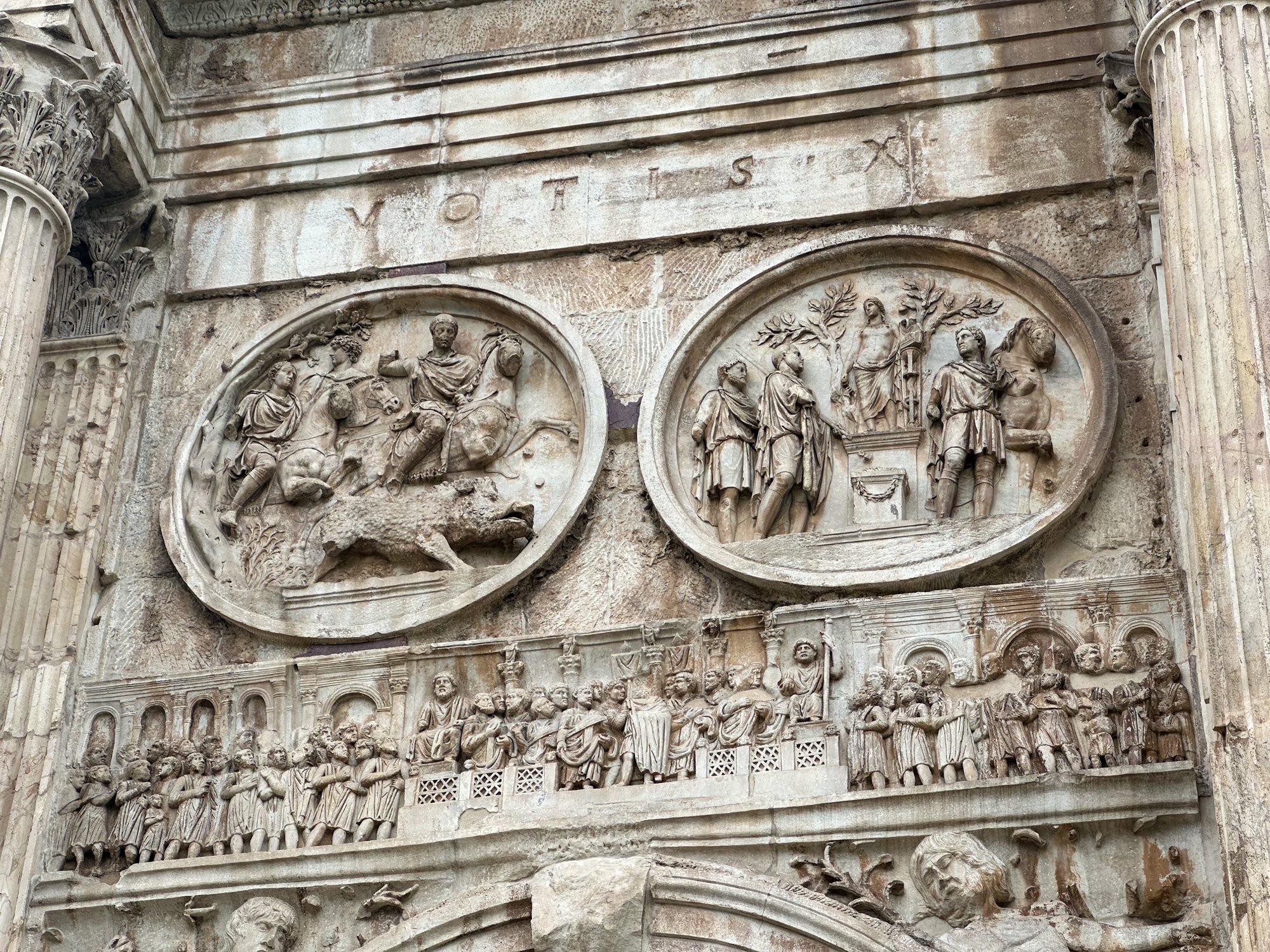
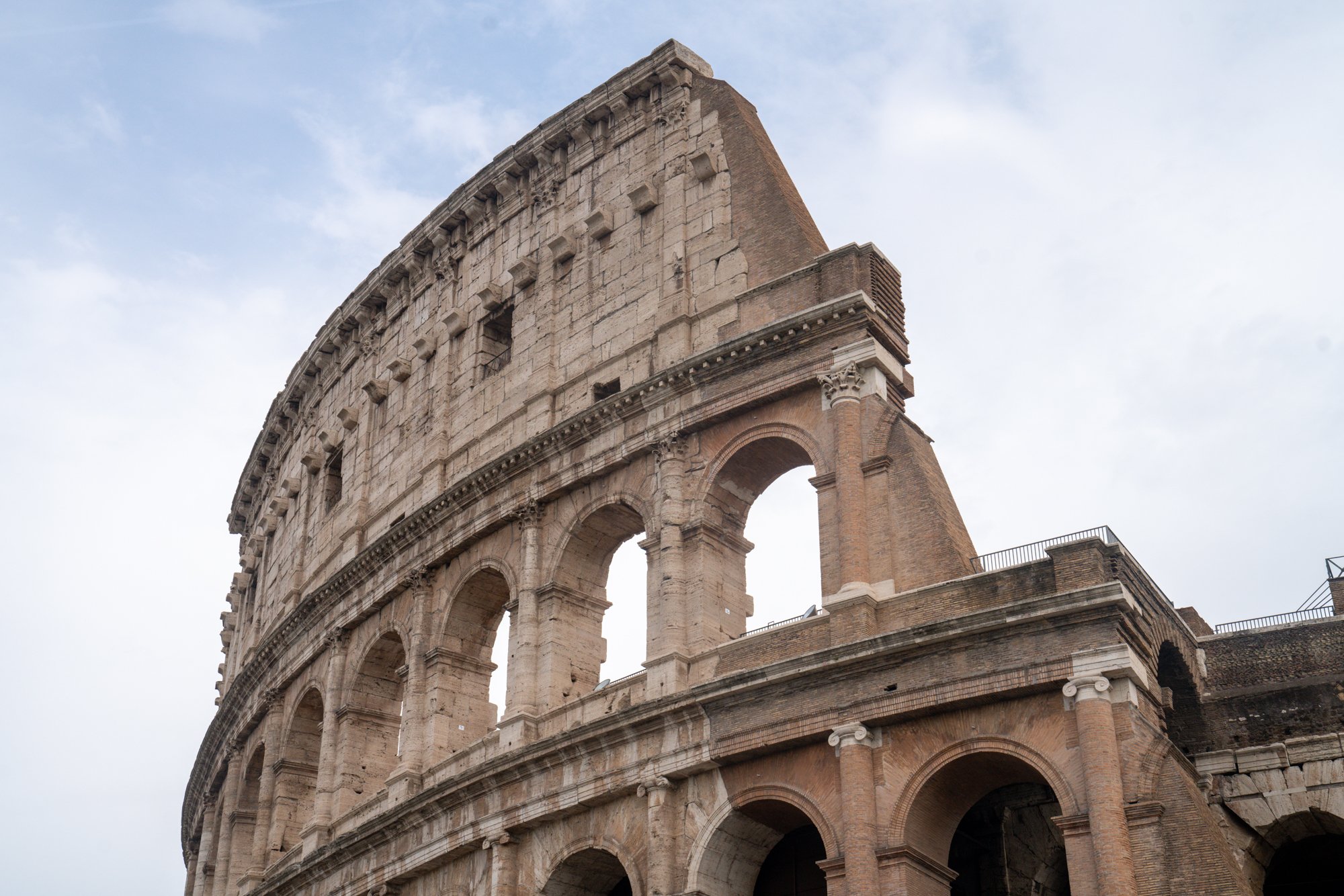
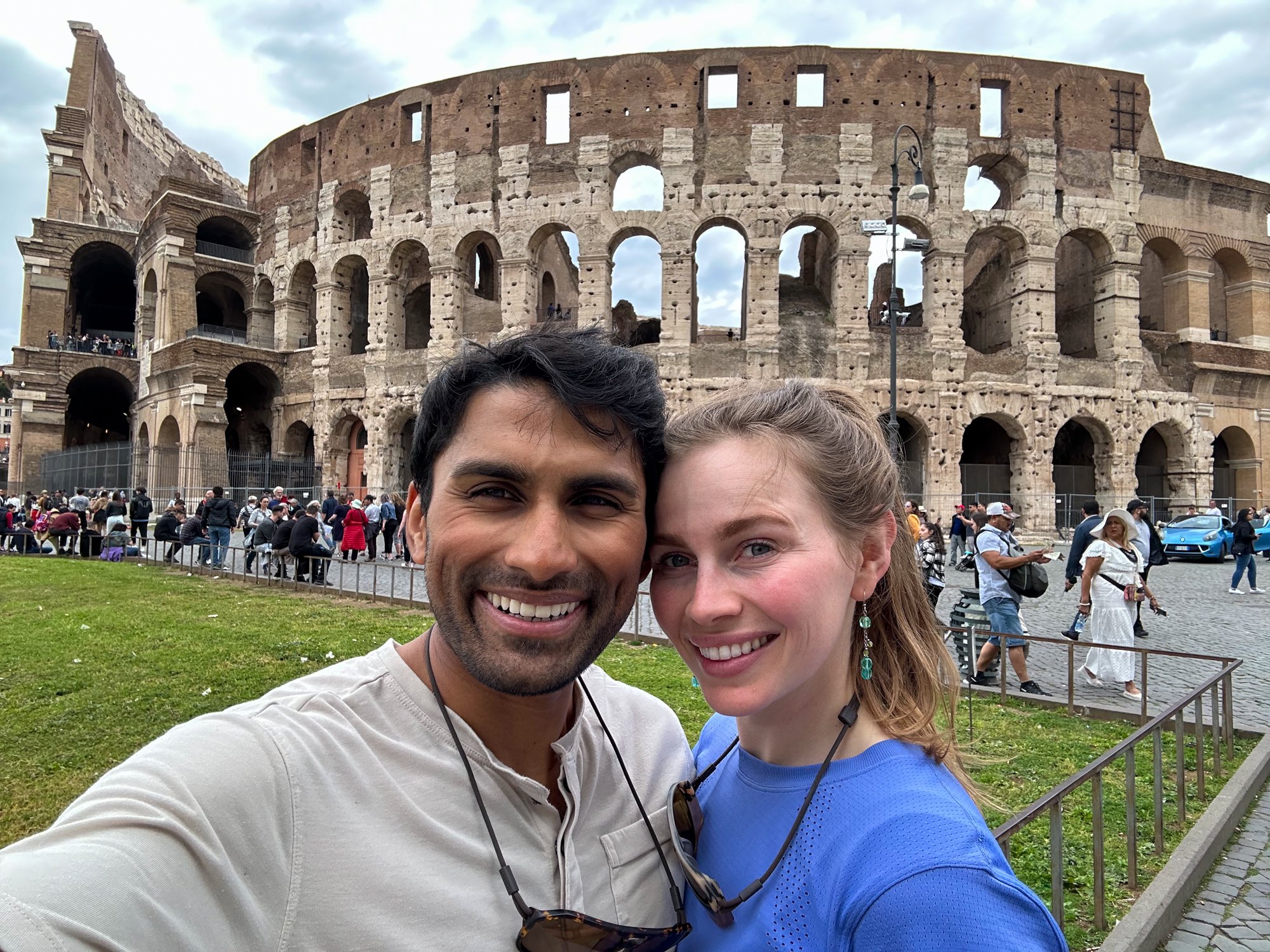

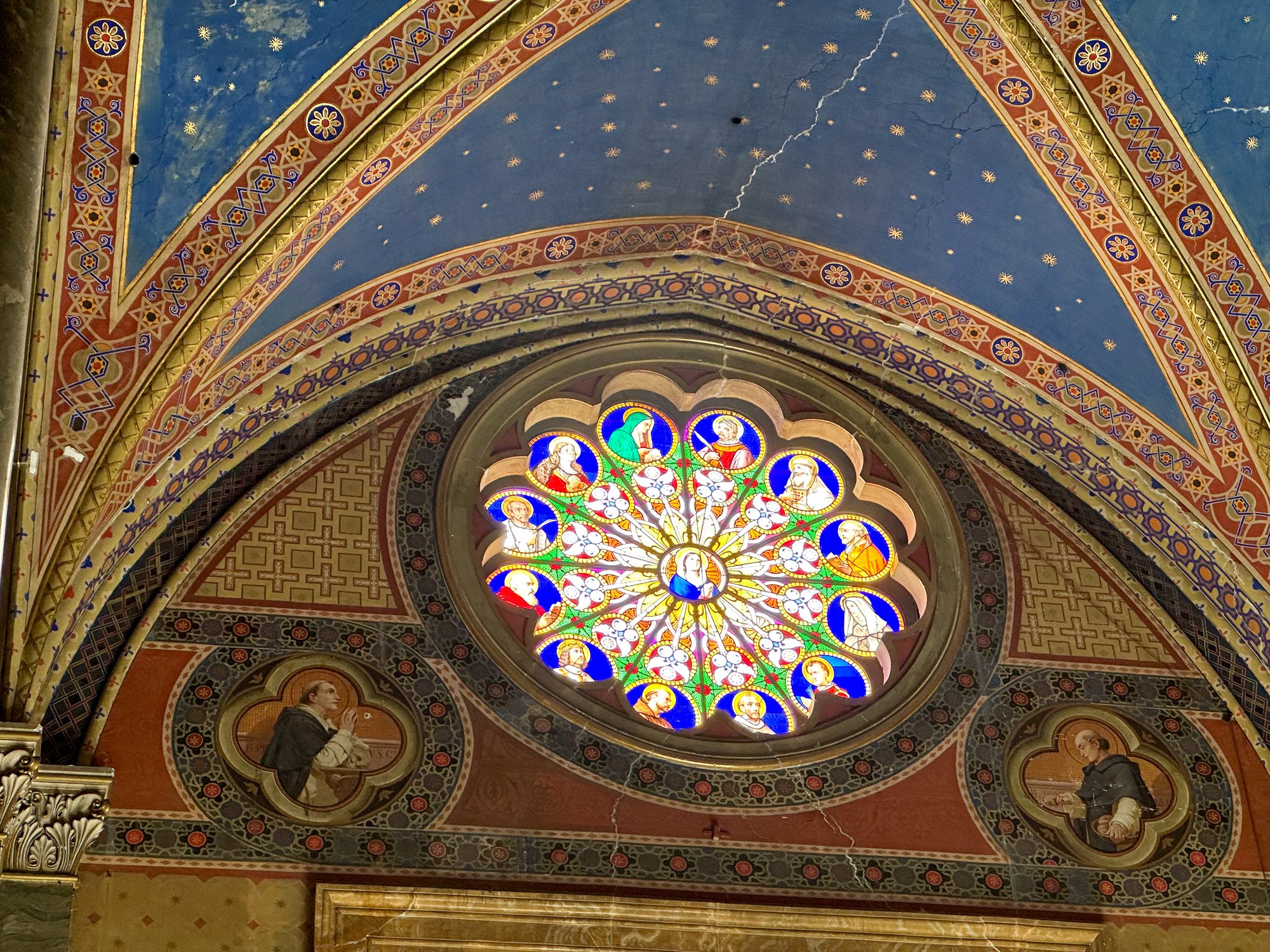
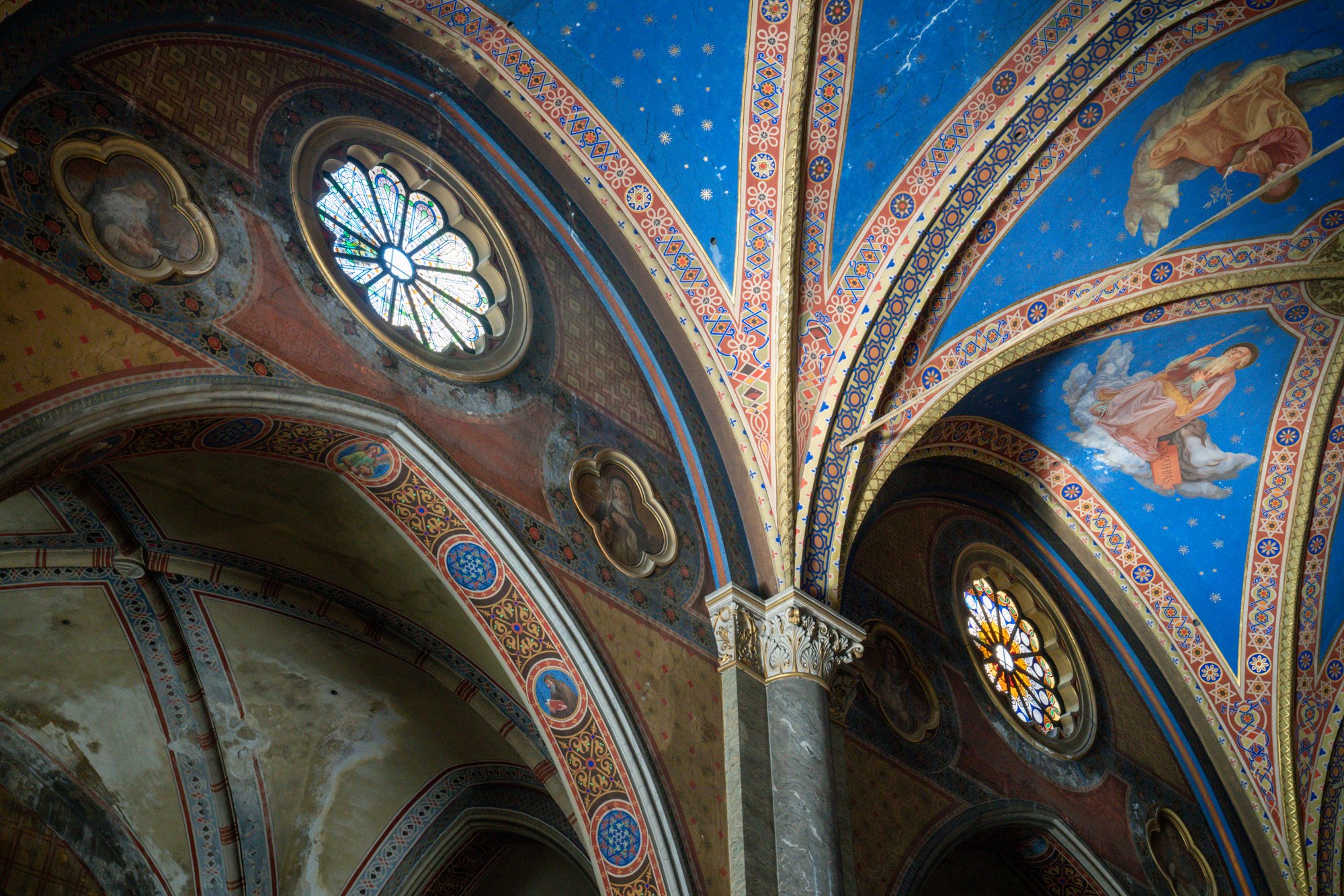

After walking several more miles, I noticed my knee wasn’t hurting. The nearly 500 miles of bike riding (over 42,000ft elevation gain) had made my legs much stronger. I’d be going into ACL reconstruction with a deck stacked in my favor. We celebrated by getting gelato at two places. One of the flavors was a wild strawberry (fragola di bosco) sorbet that Leah said was like eating a fresh strawberry and we still think about months later.
Finally we ended our honeymoon with dinner at a Roman restaurant, far from the tourists thanks to the many miles we walked. The owner, Lucia, was the classic young Italian nonna who was impressed with how much I could eat, but more so by my basic Italian. She kept saying “Bravo!” after she realized I knew the names of certain ingredients and dishes. After our meal, she held our hands to thank us for coming which wasn’t something she did with any other table.
Back at the airport hotel, we set our alarms for a 3am wake-up. Our spectacular honeymoon would be capped off by a grueling flight back! I hoped that I’d get some sleep on the journey, with lots of pizza, pasta, and gelato to dream about.
I knew nothing about Corsica when we began to plan for this visit just nine days before flying out, which is what made this trip so special to me. I had few expectations going in, so during each day of the trip I had genuine awe and surprise at what I saw, tasted, and the people I met. Leah and I can’t say this about any other trip, but we wouldn’t hesitate to repeat nearly the exact same itinerary.
More than anything, I feel lucky to have a wife to share these incredible experiences with. I know I’ve married someone special when I think about how the best part about this trip is having done it with Leah.





